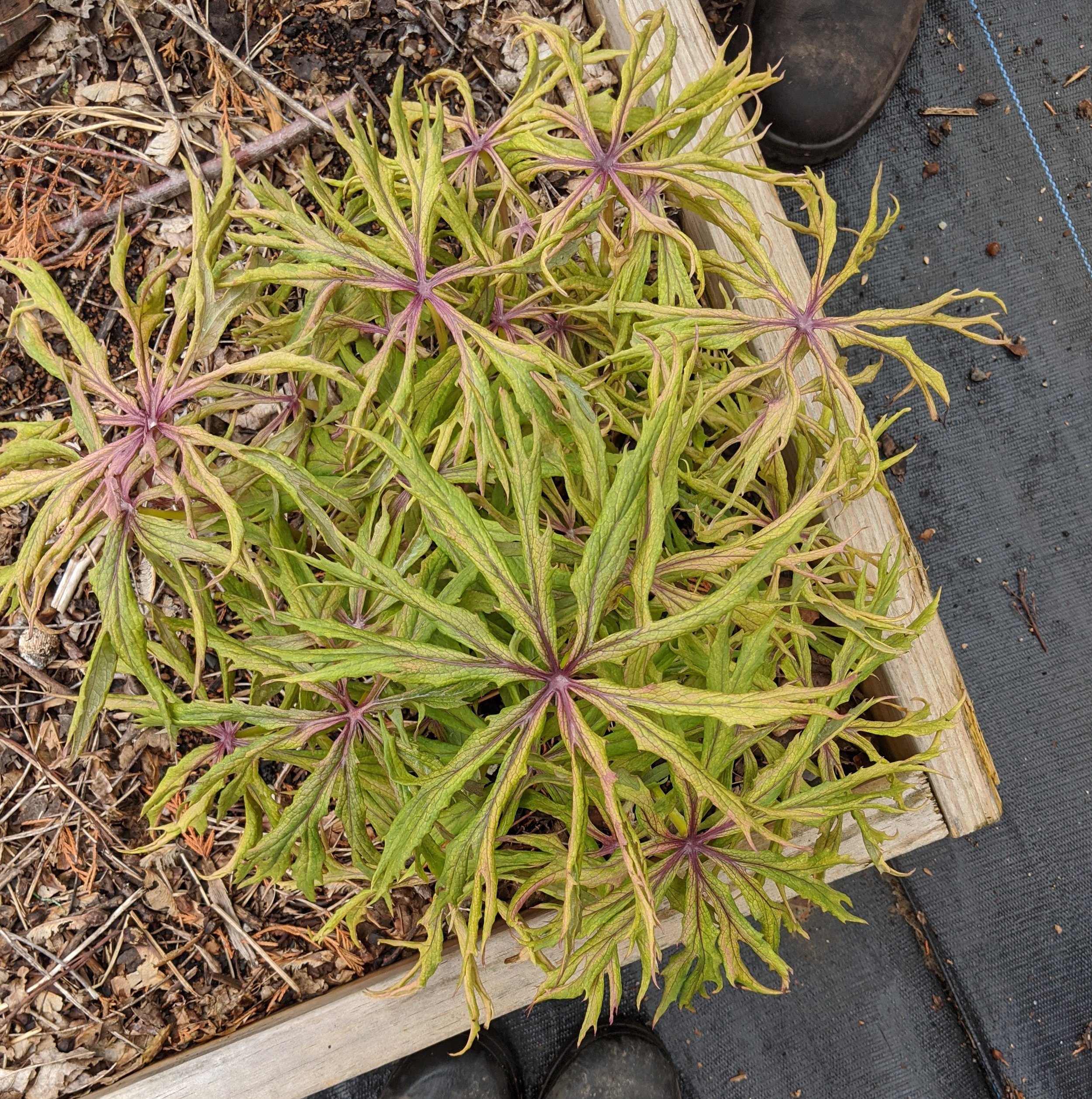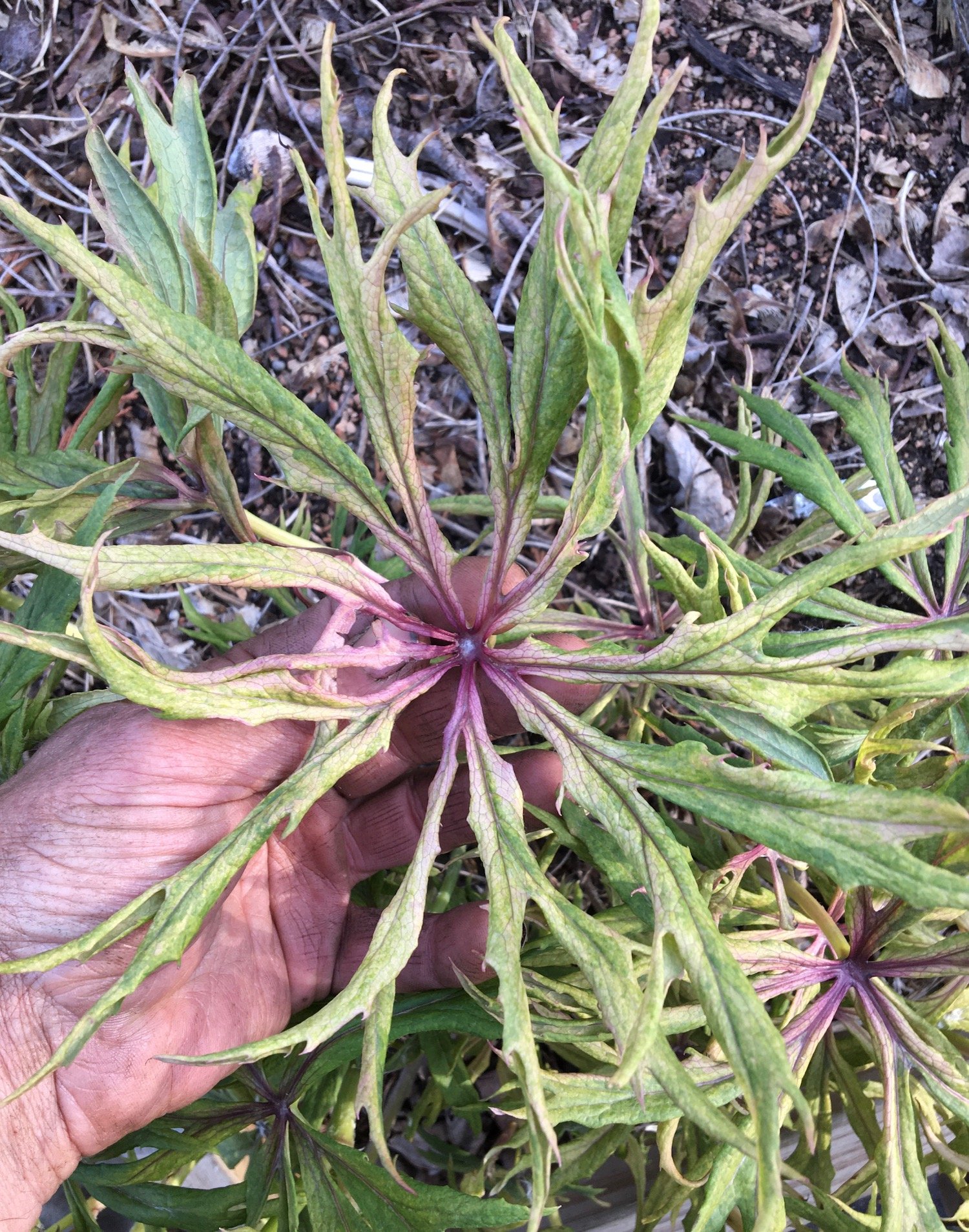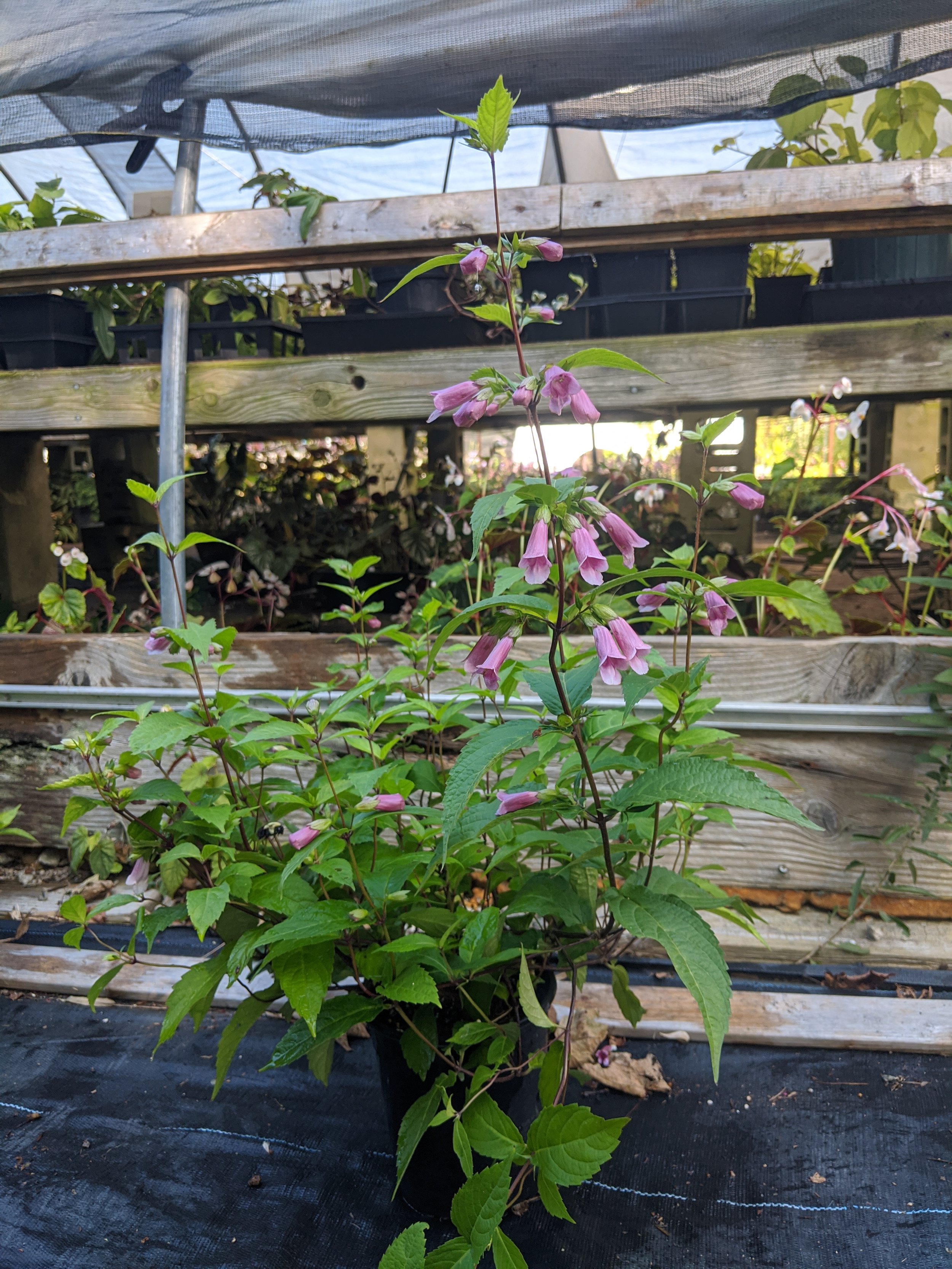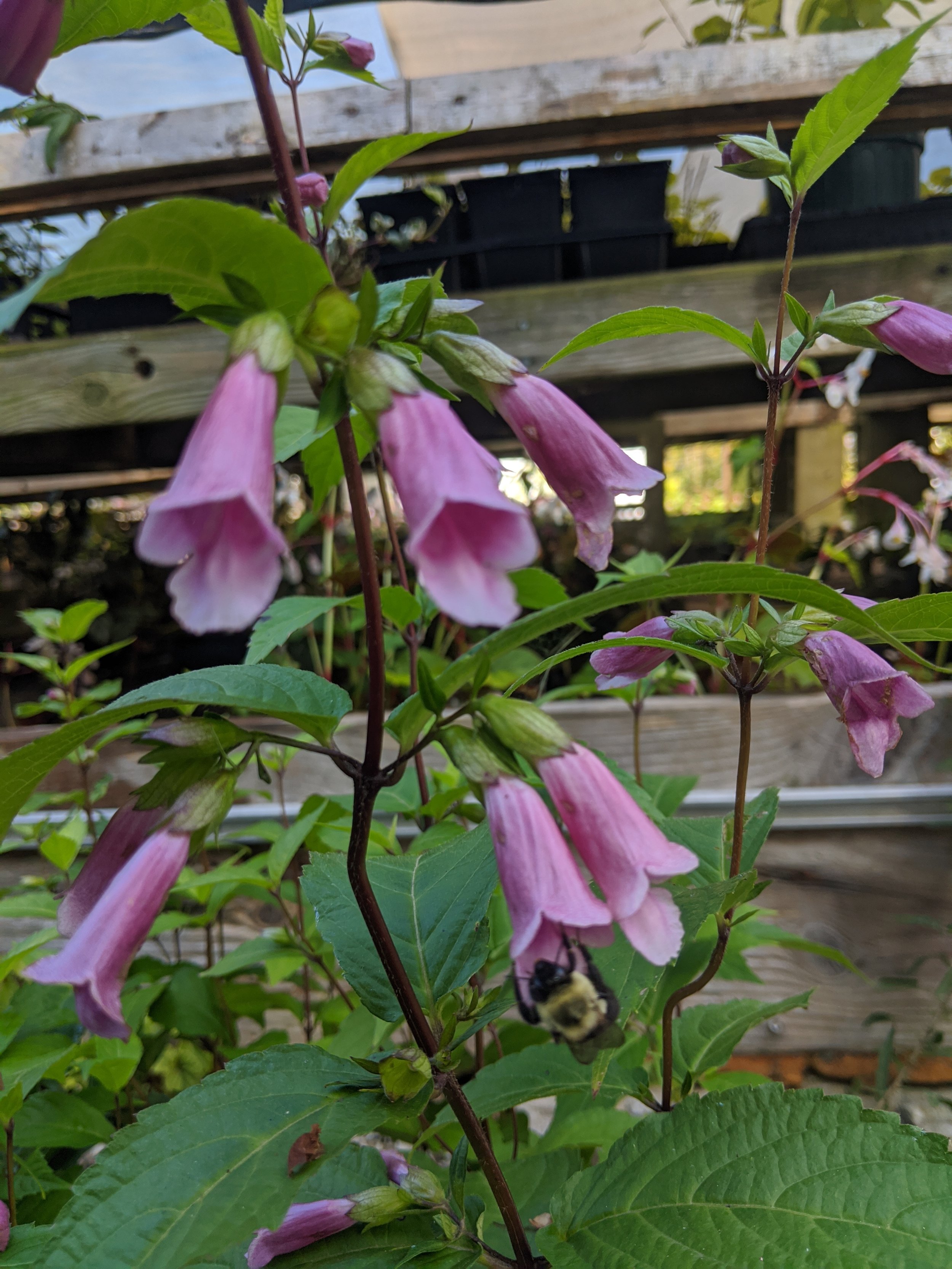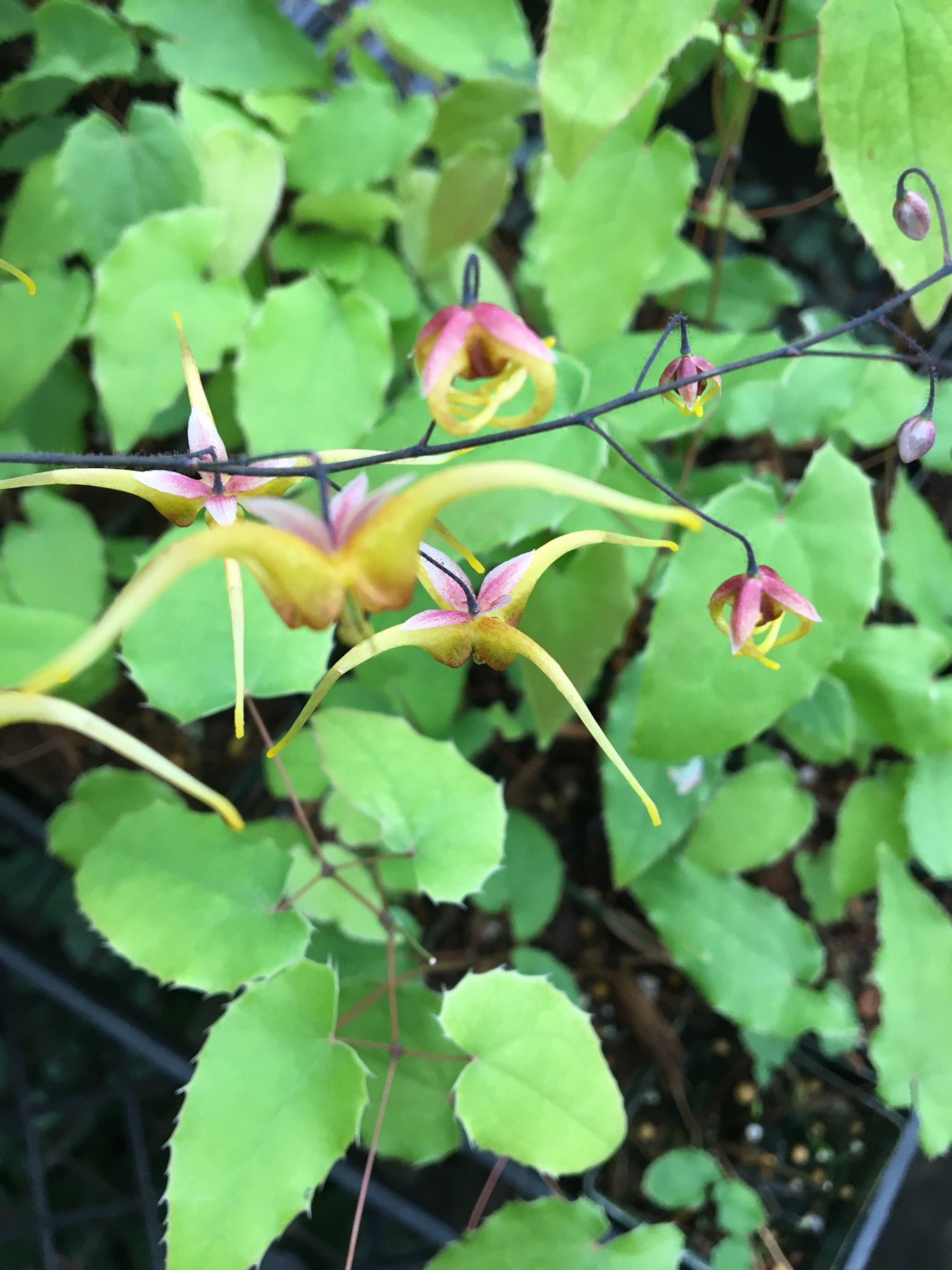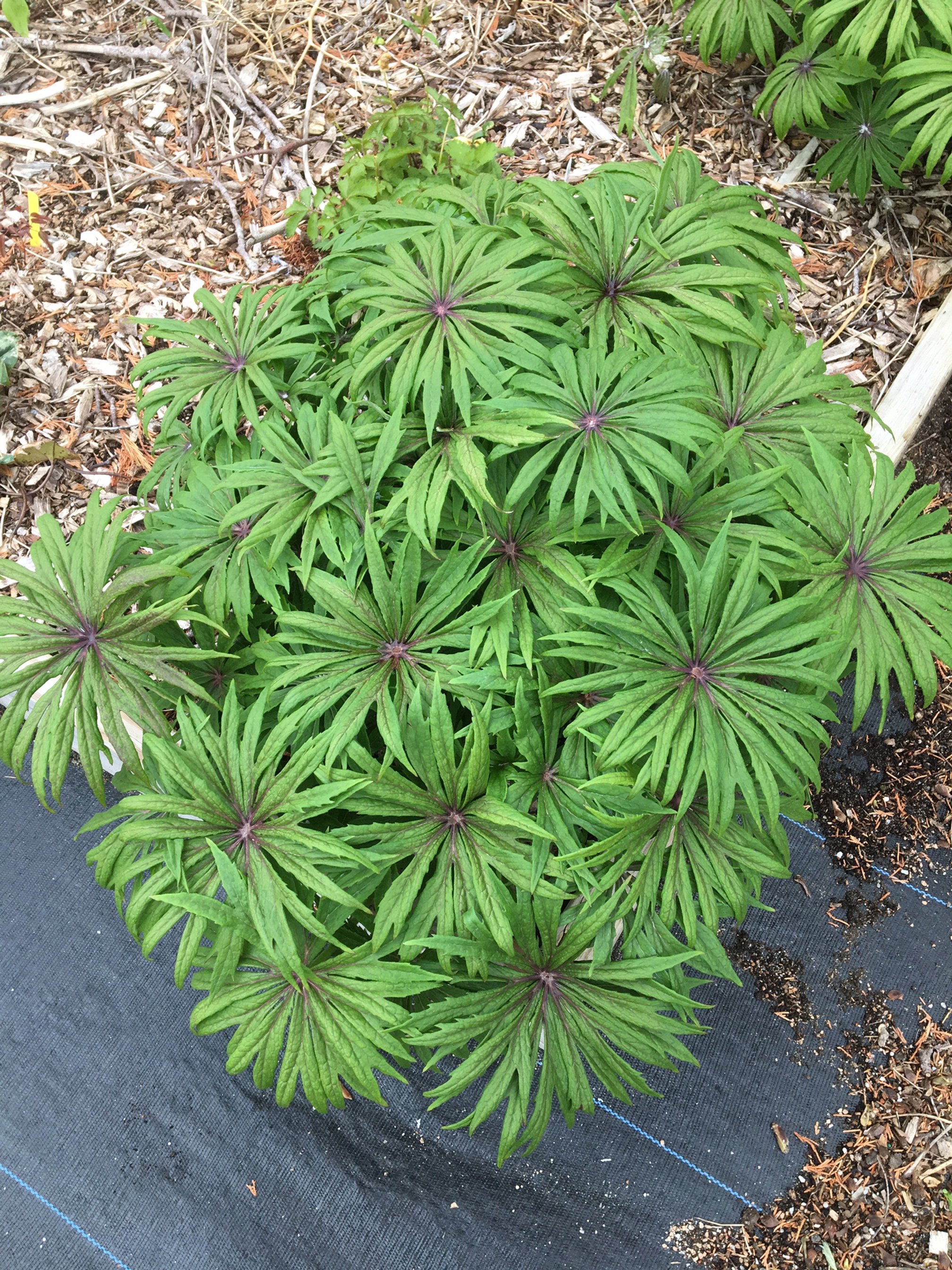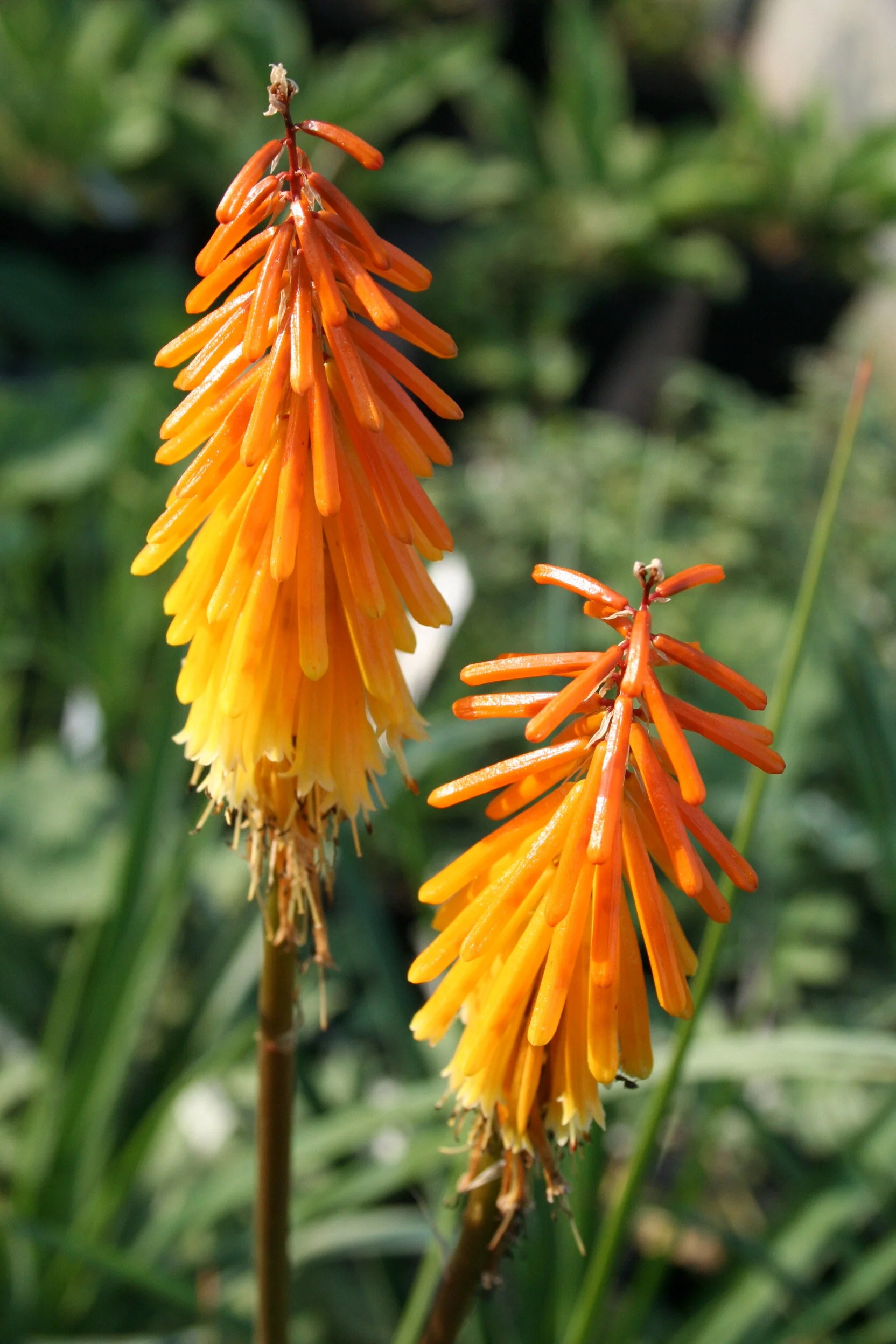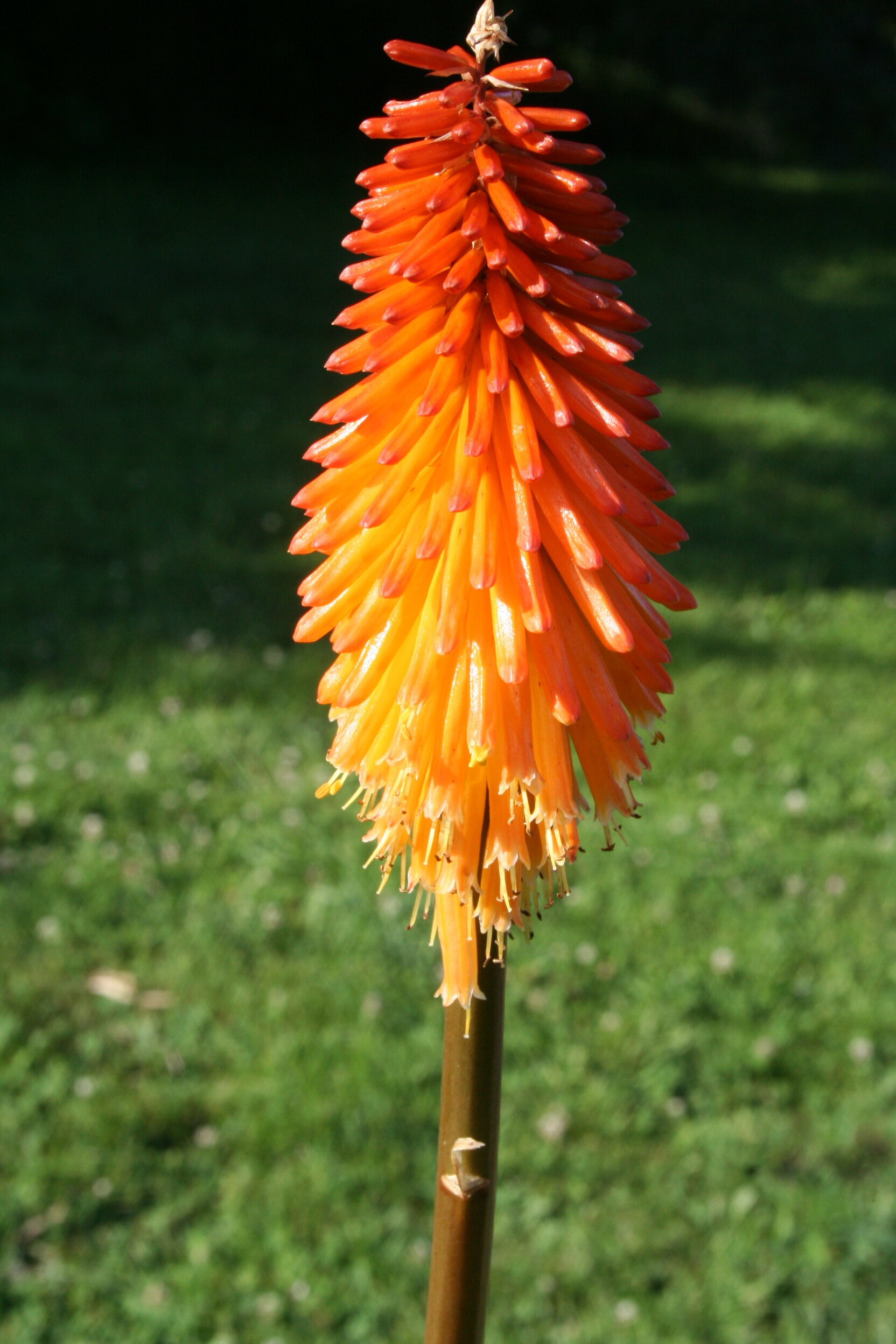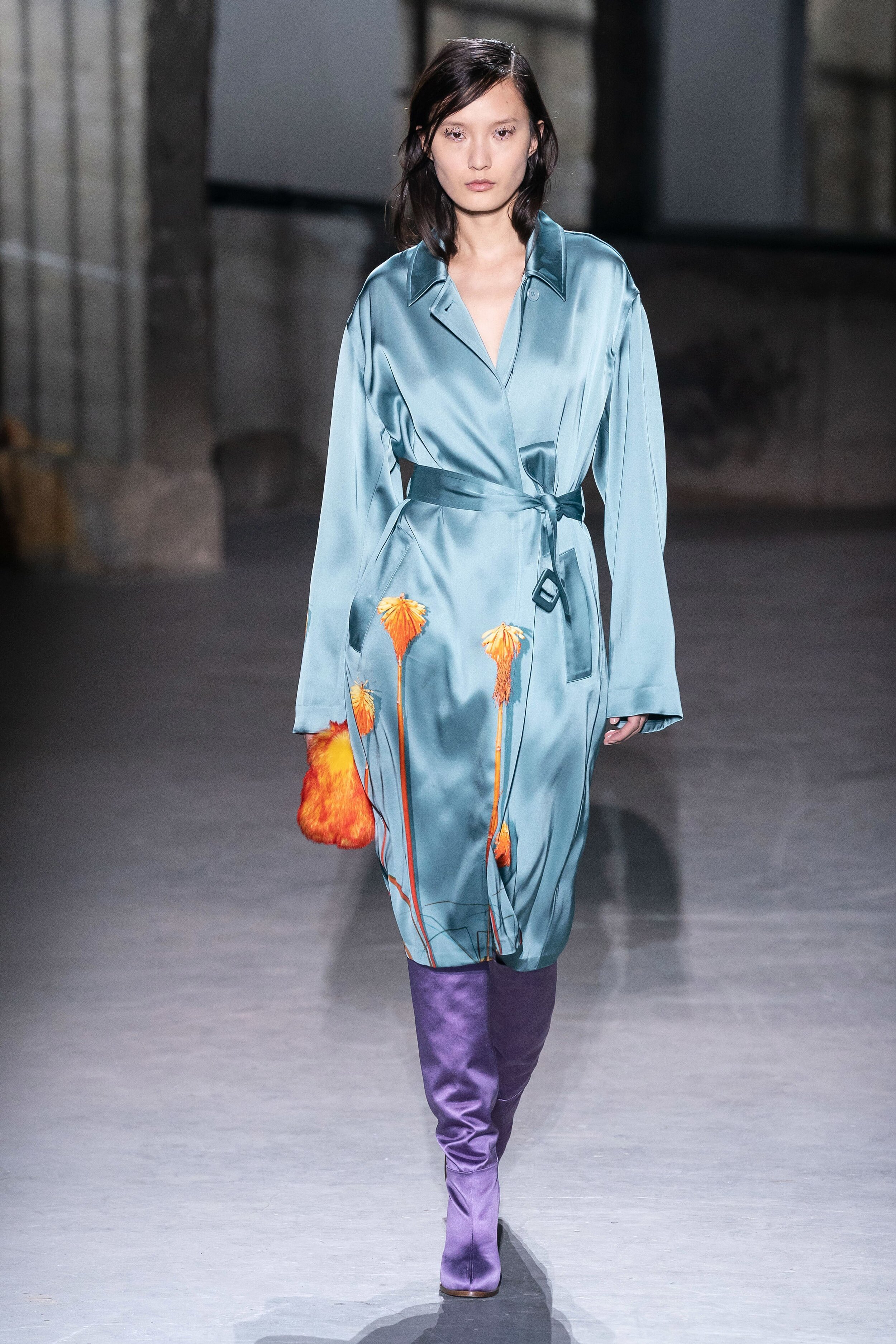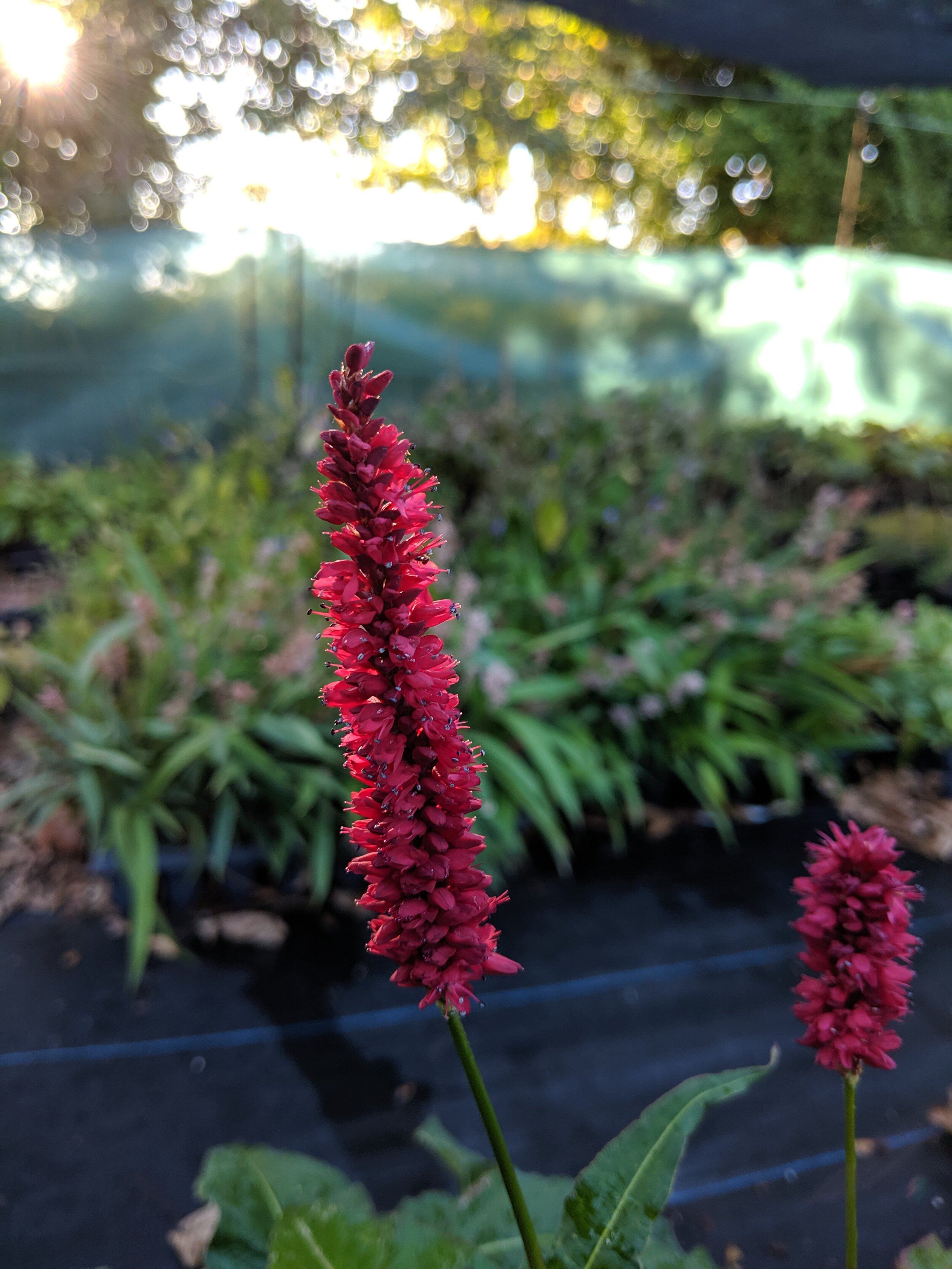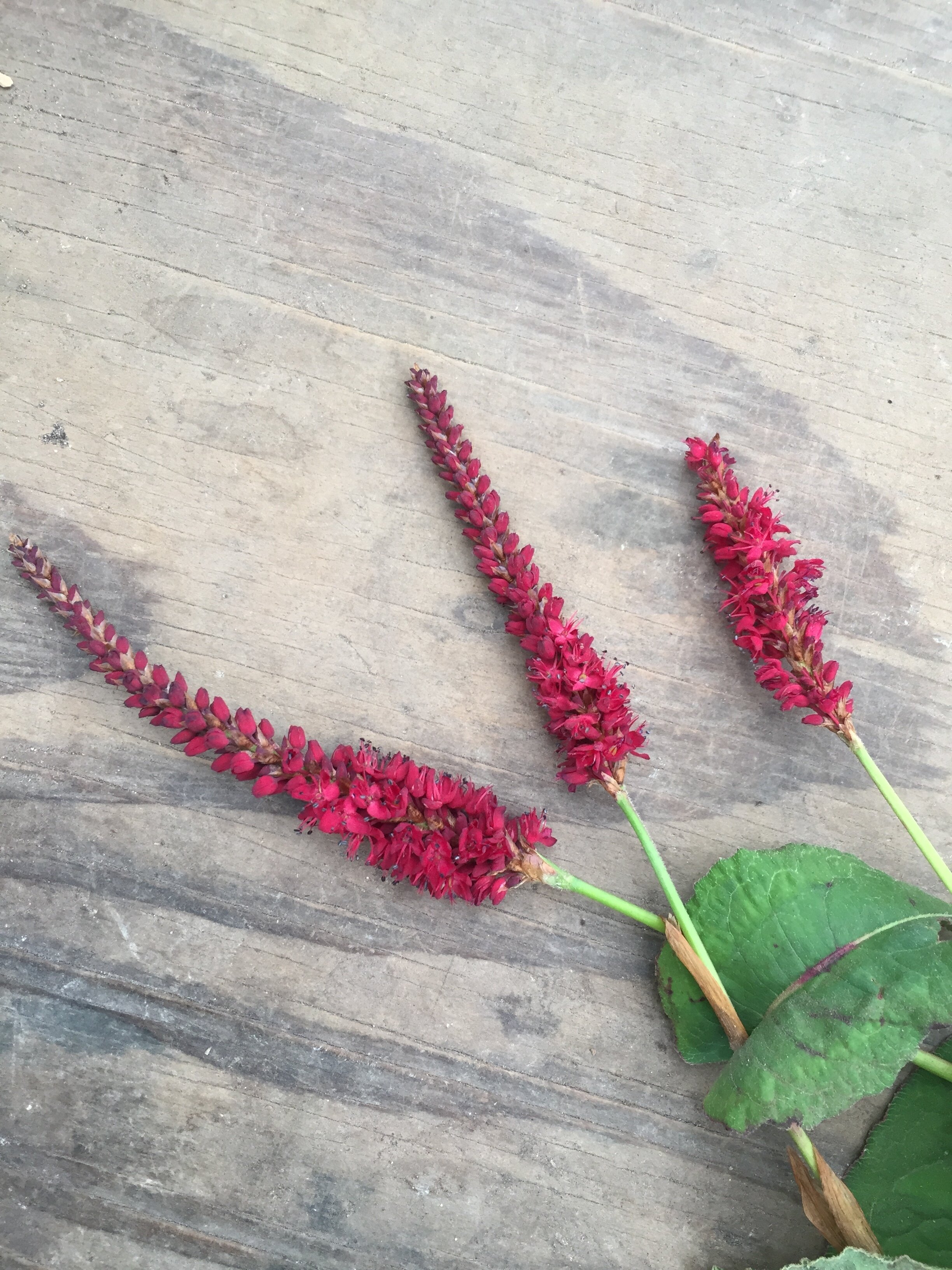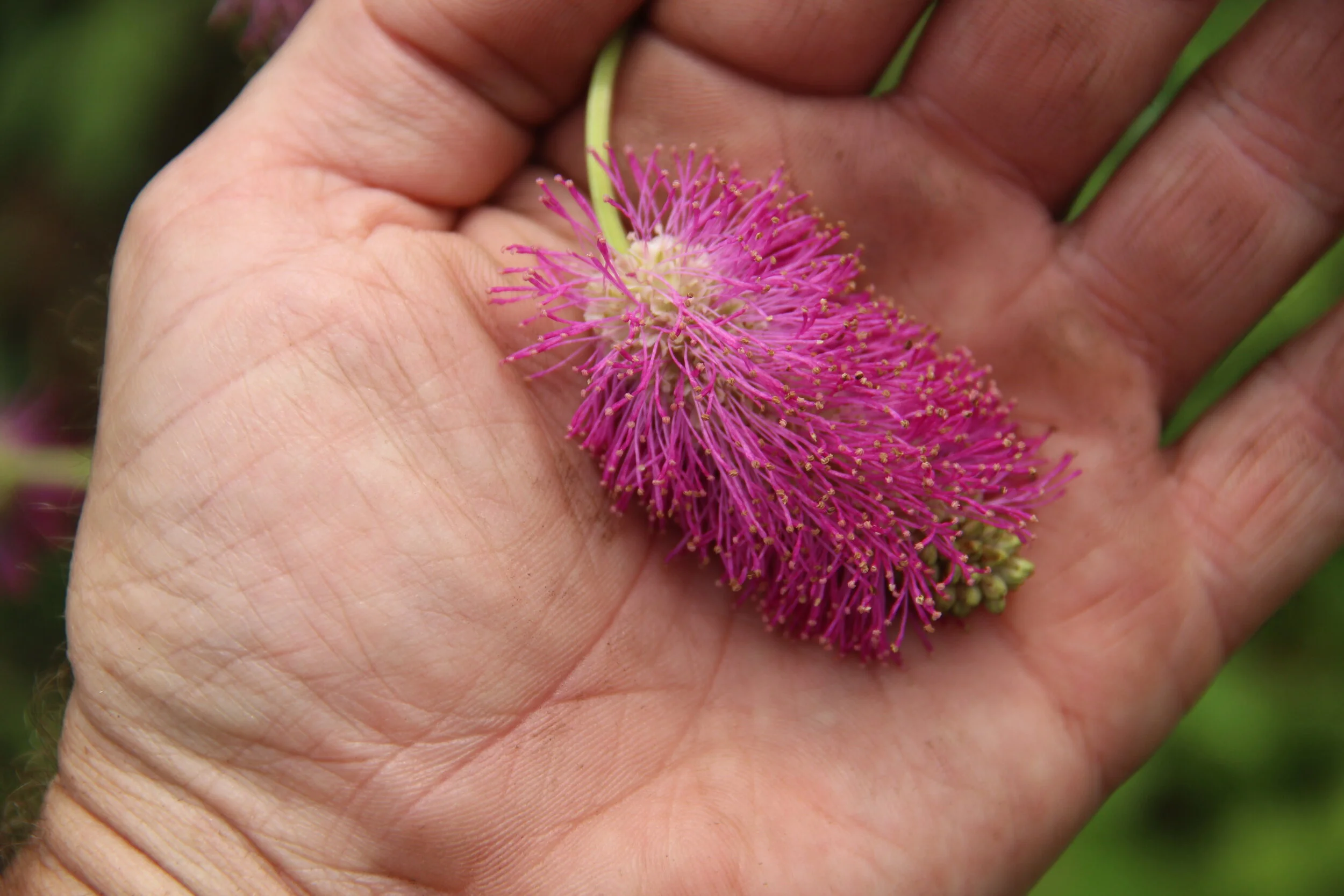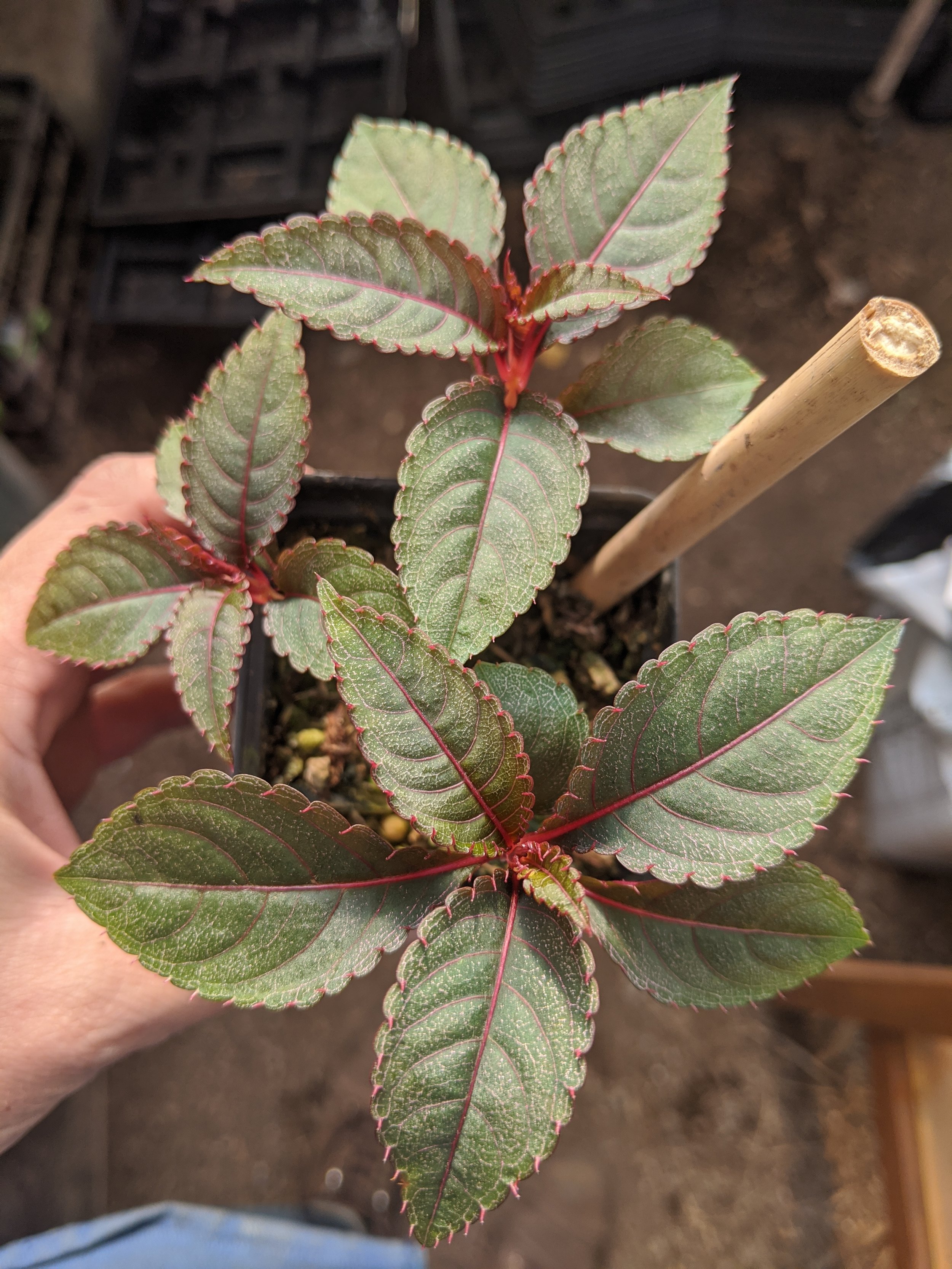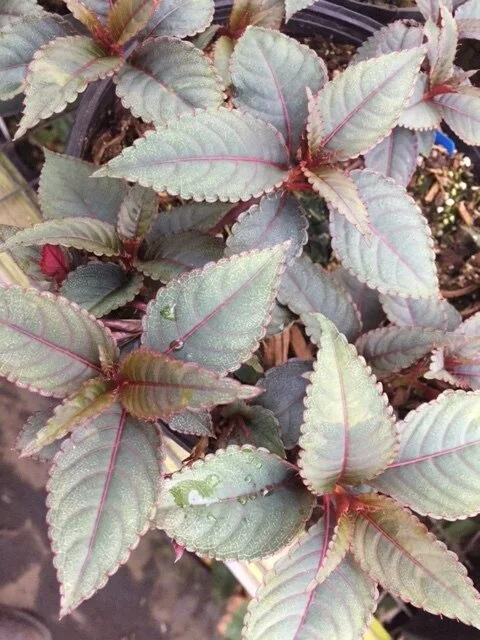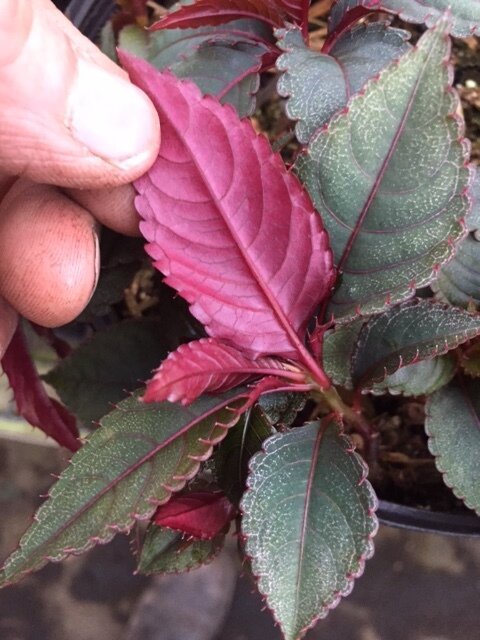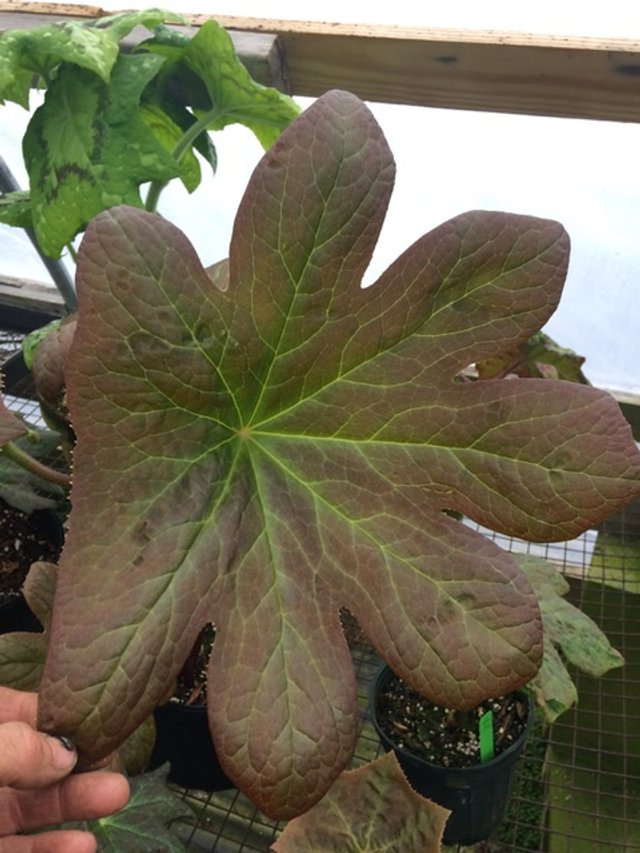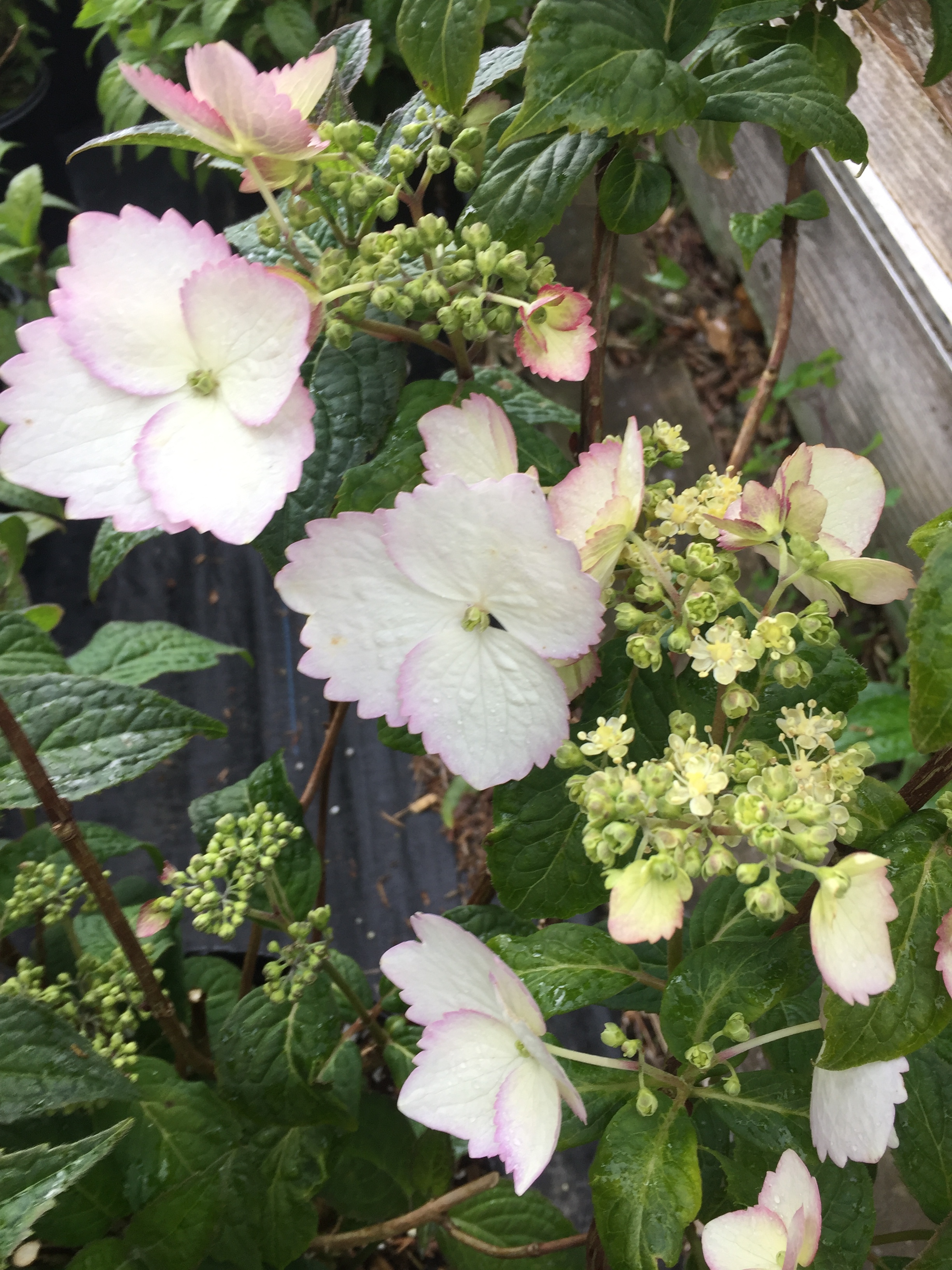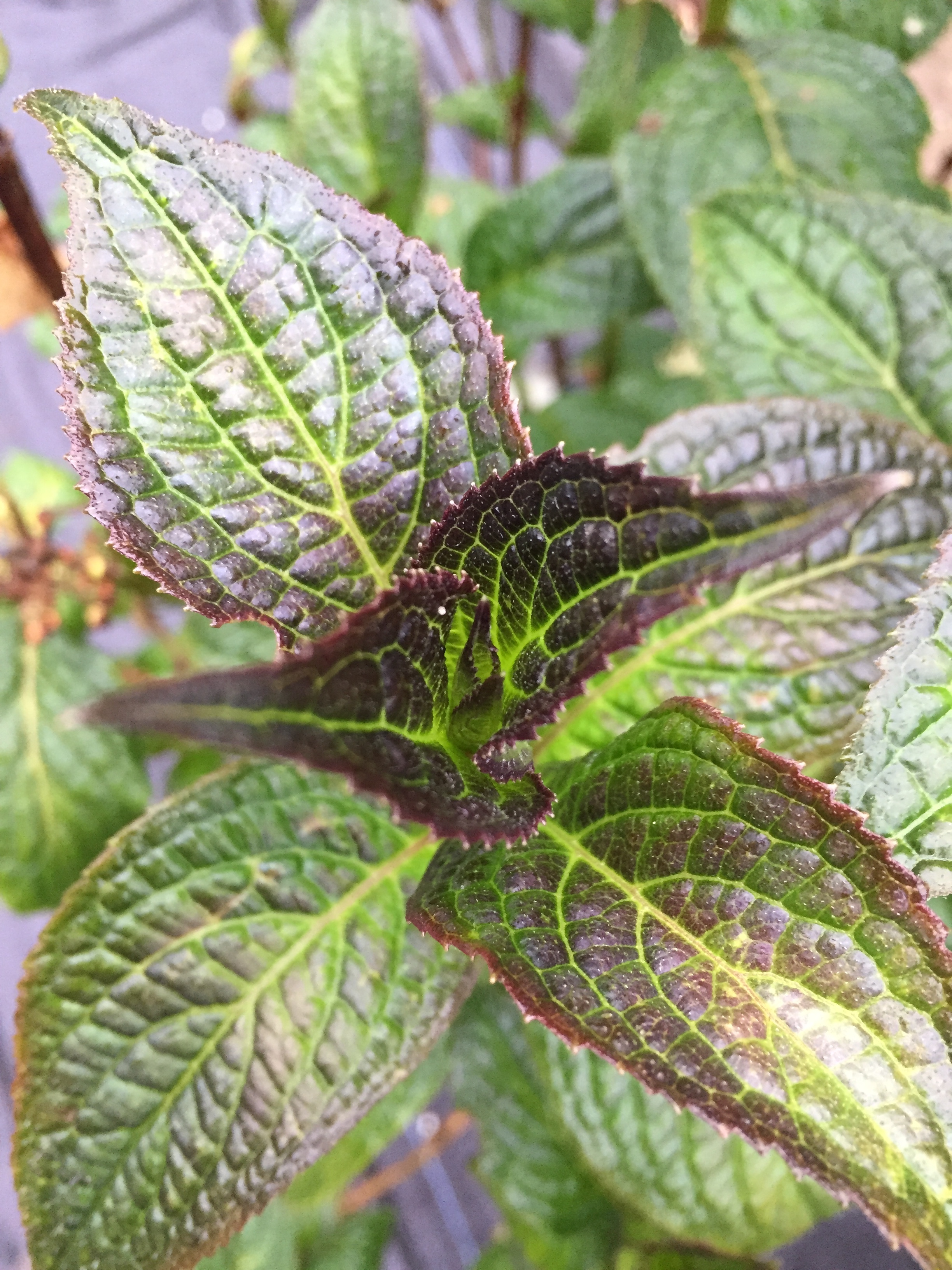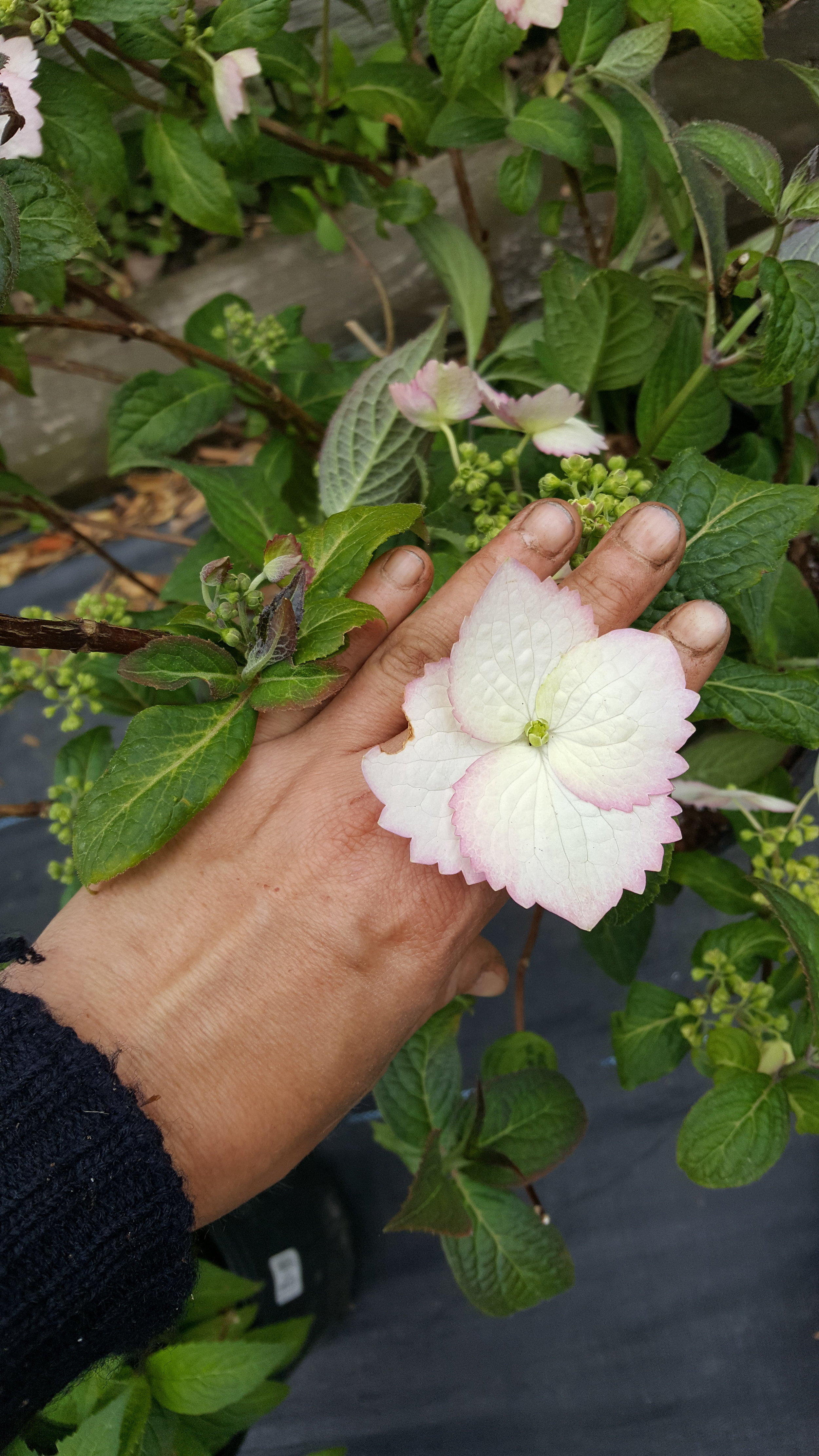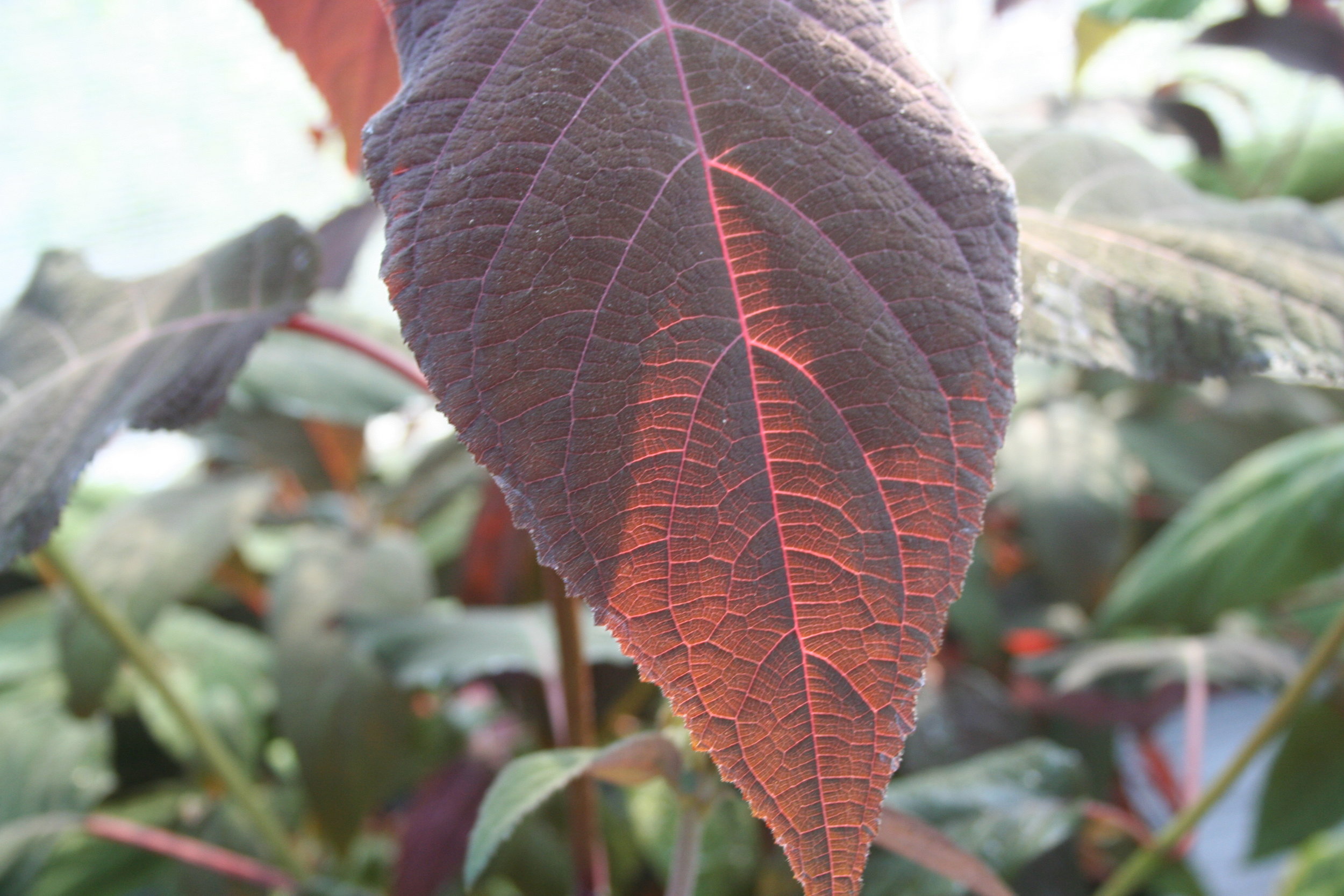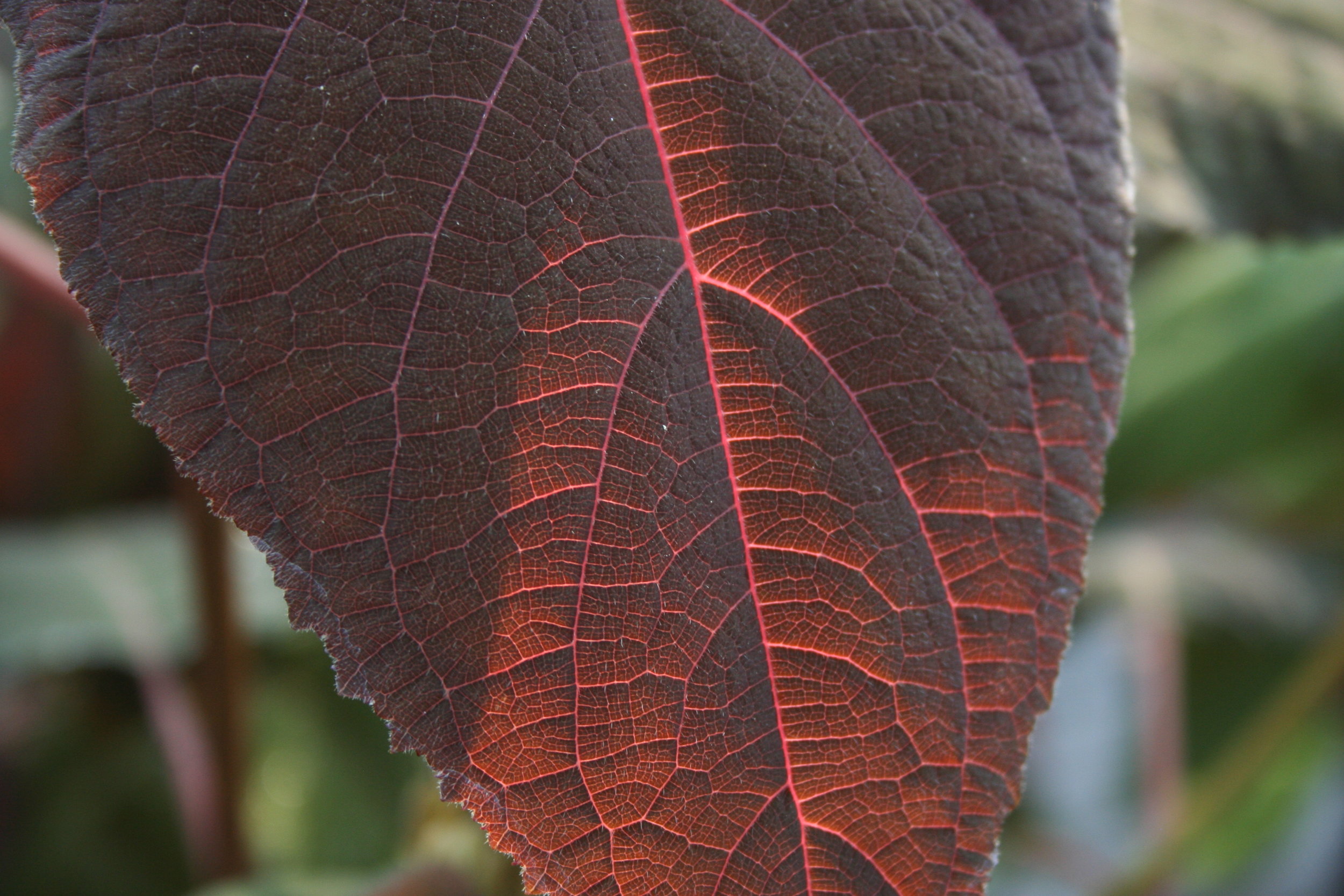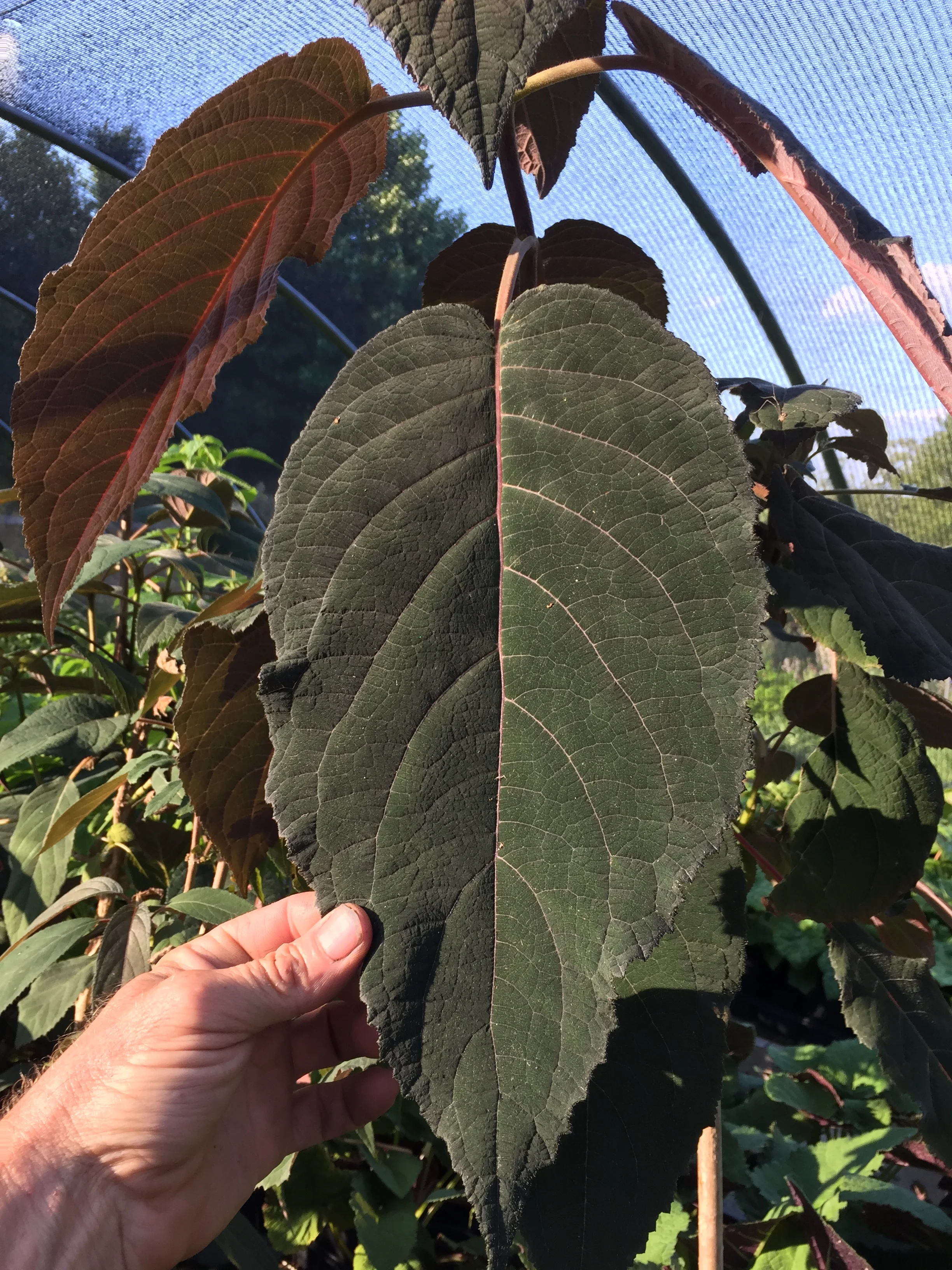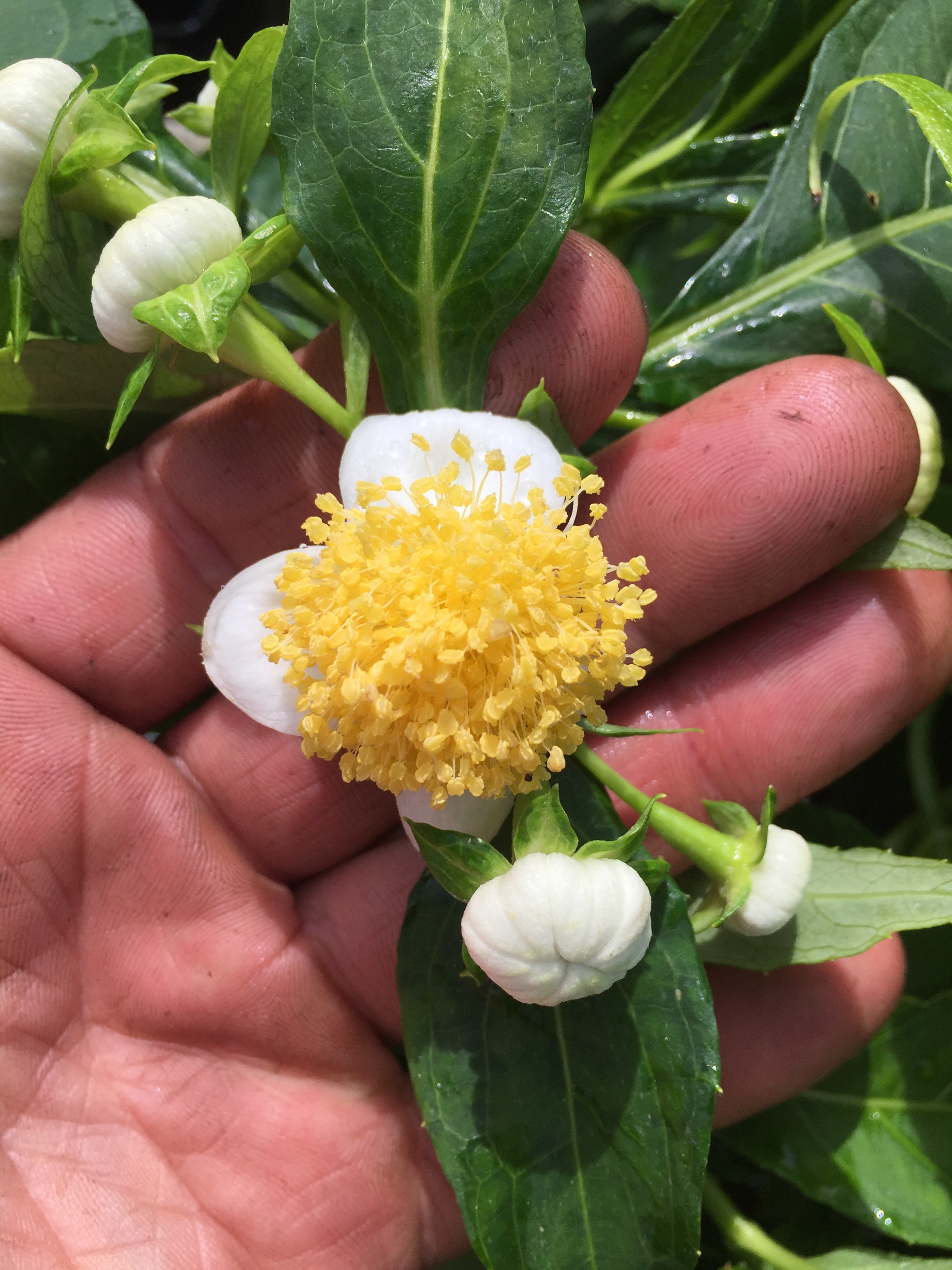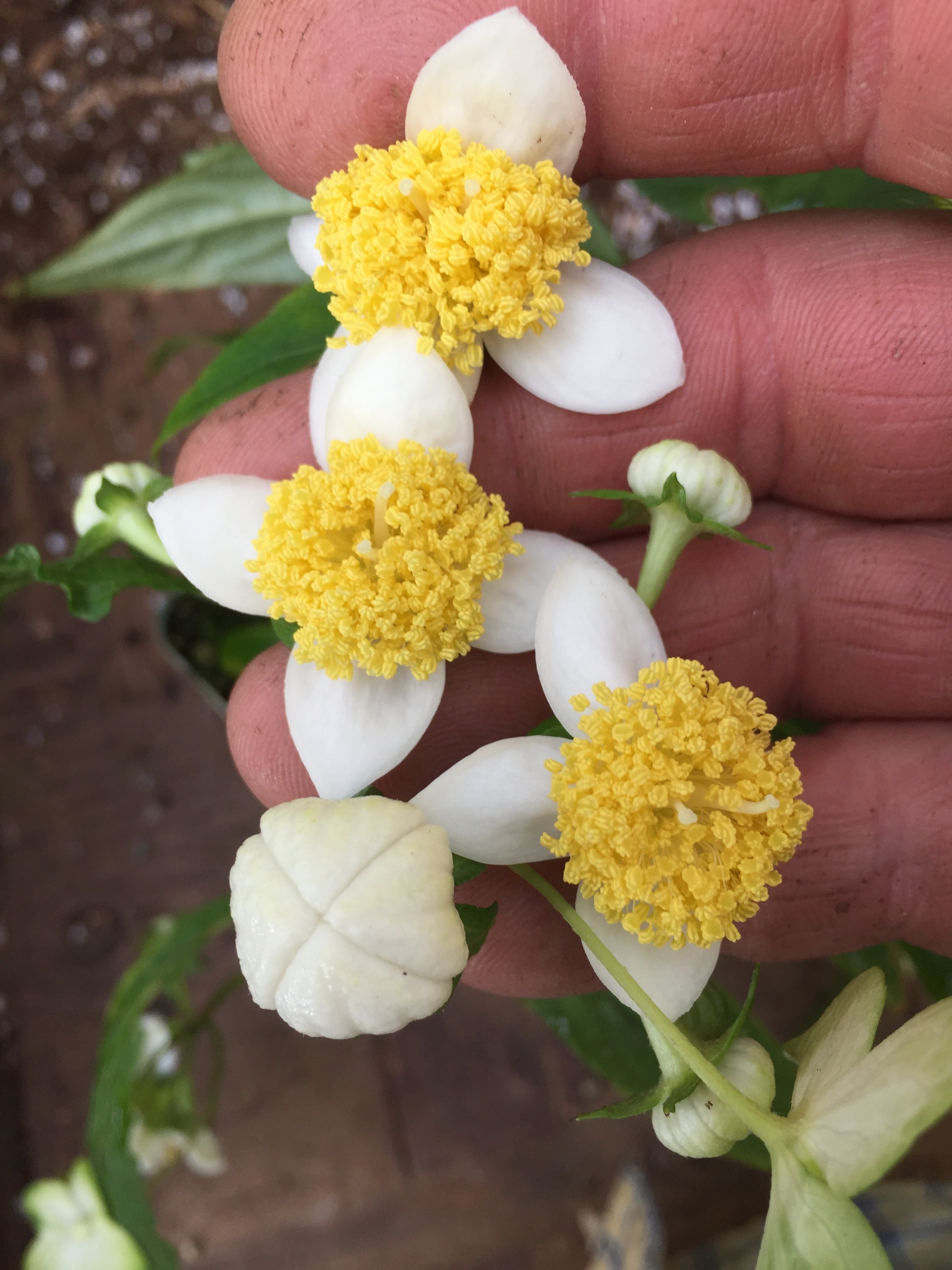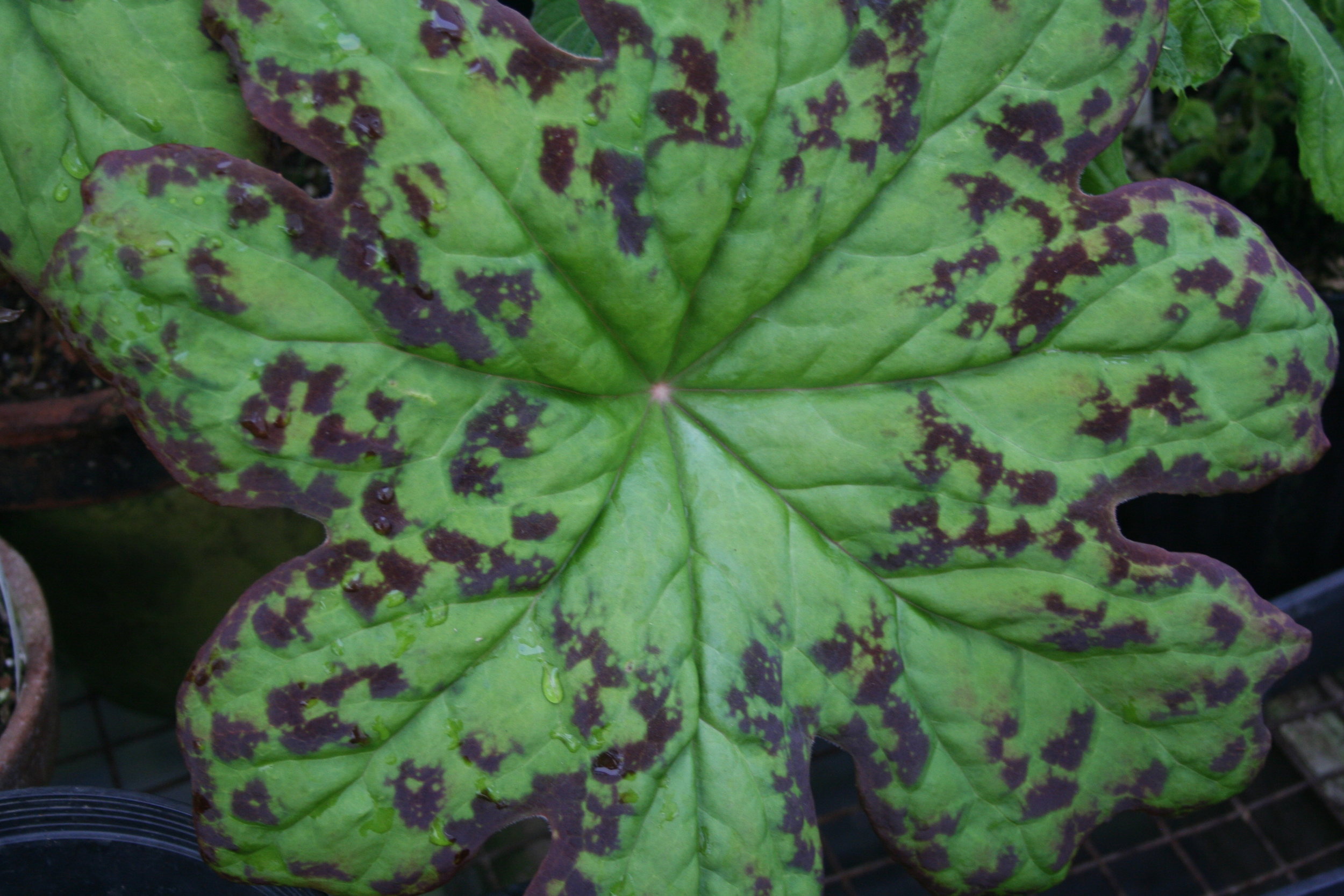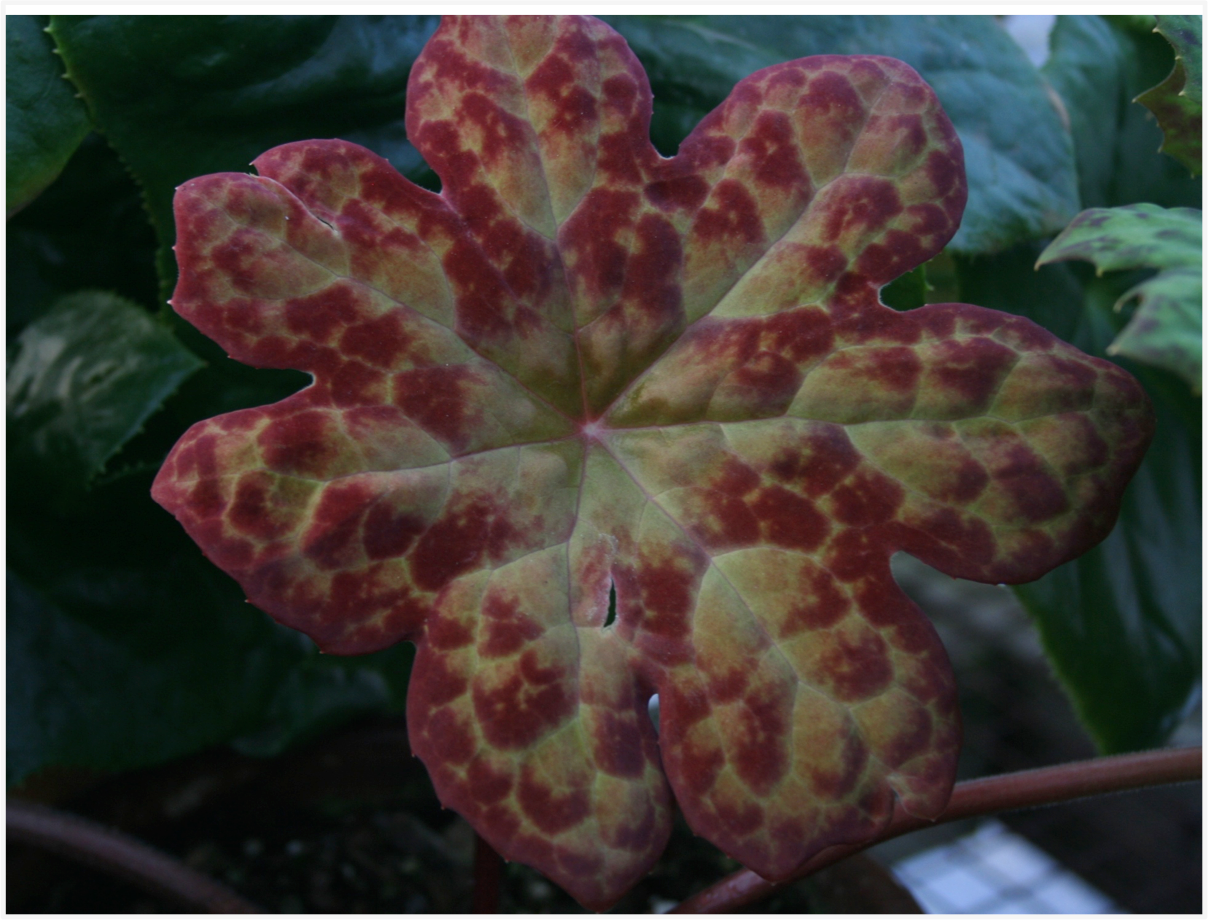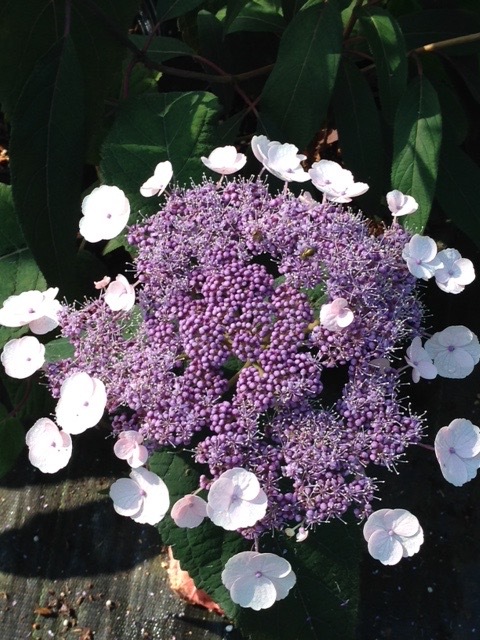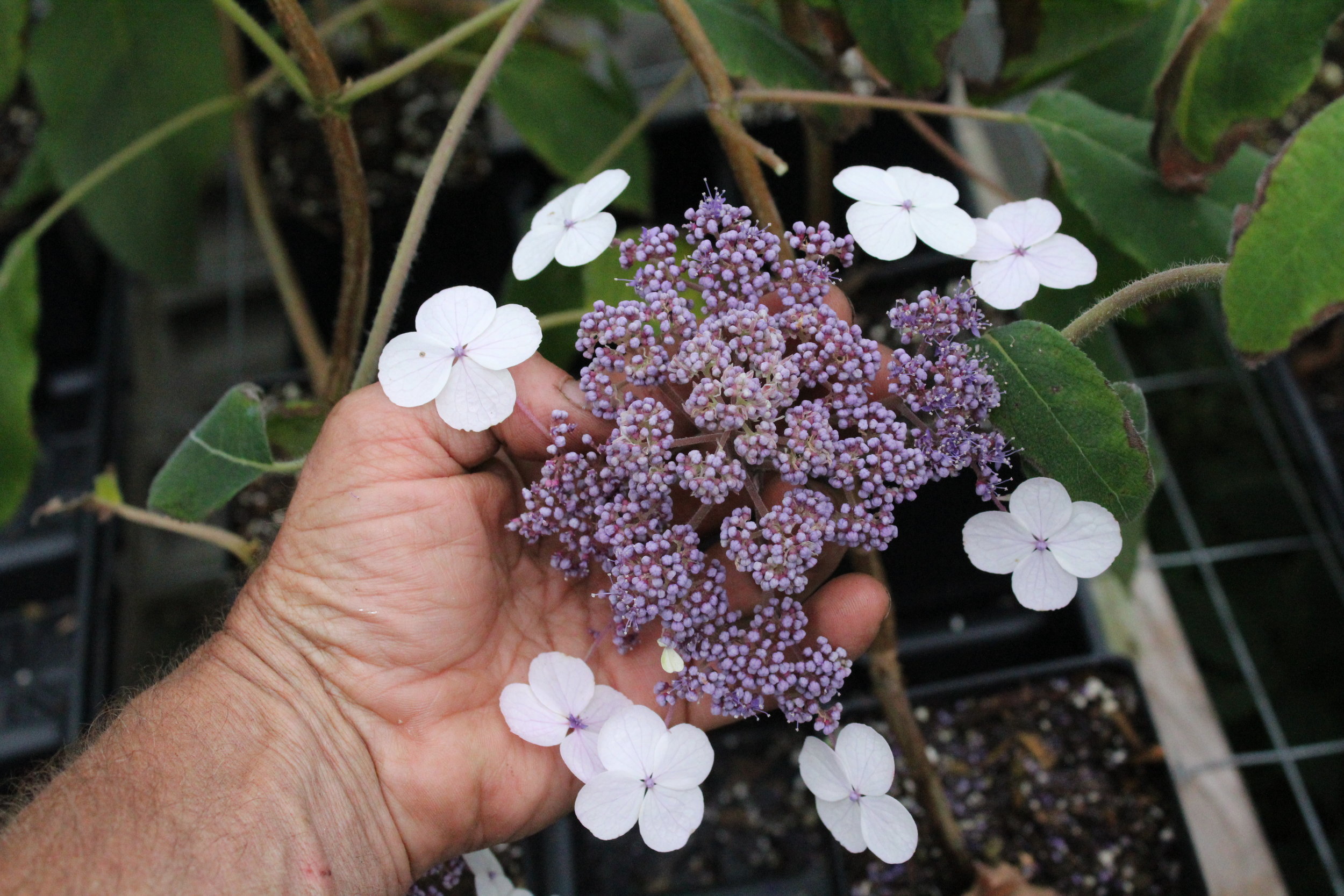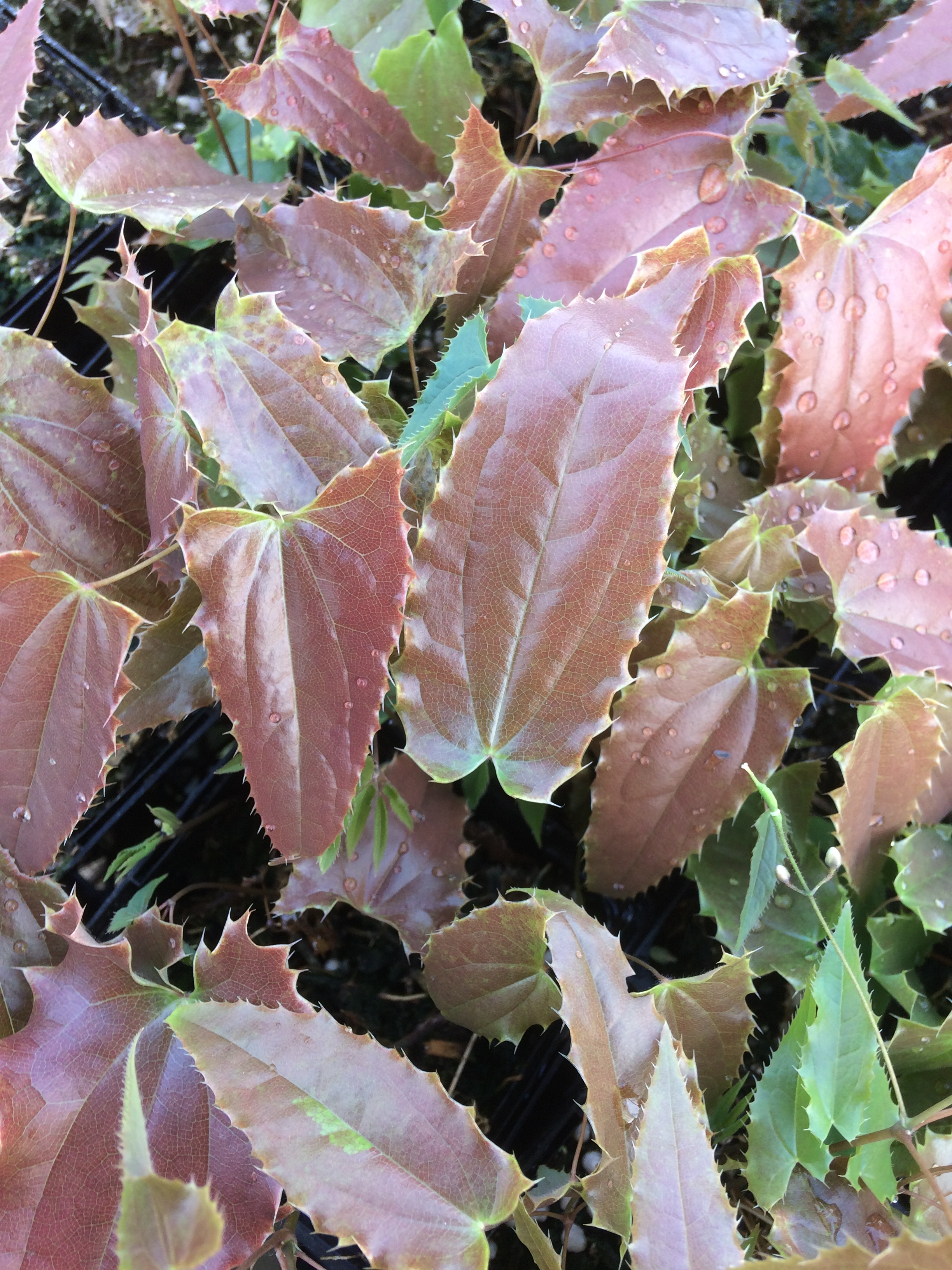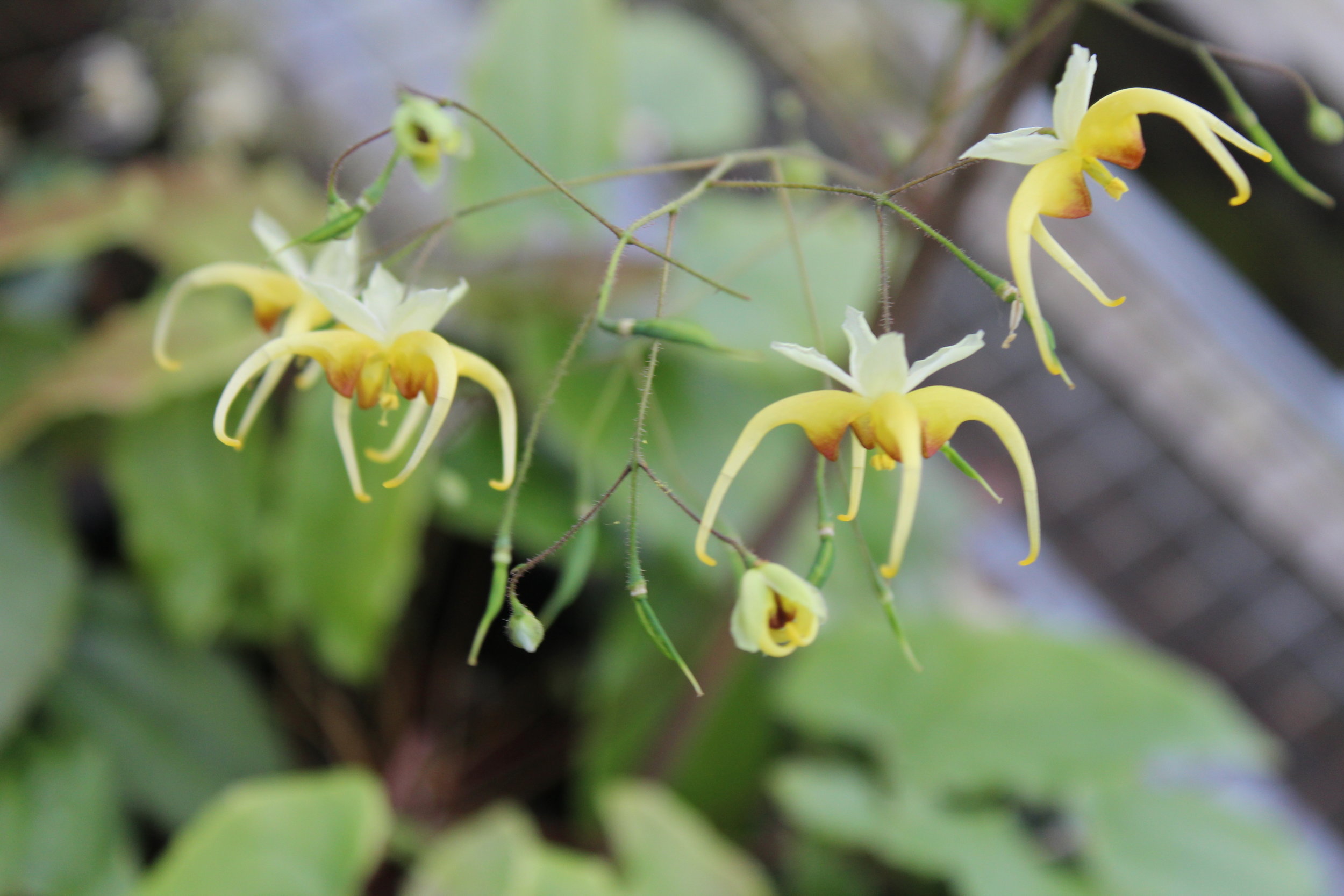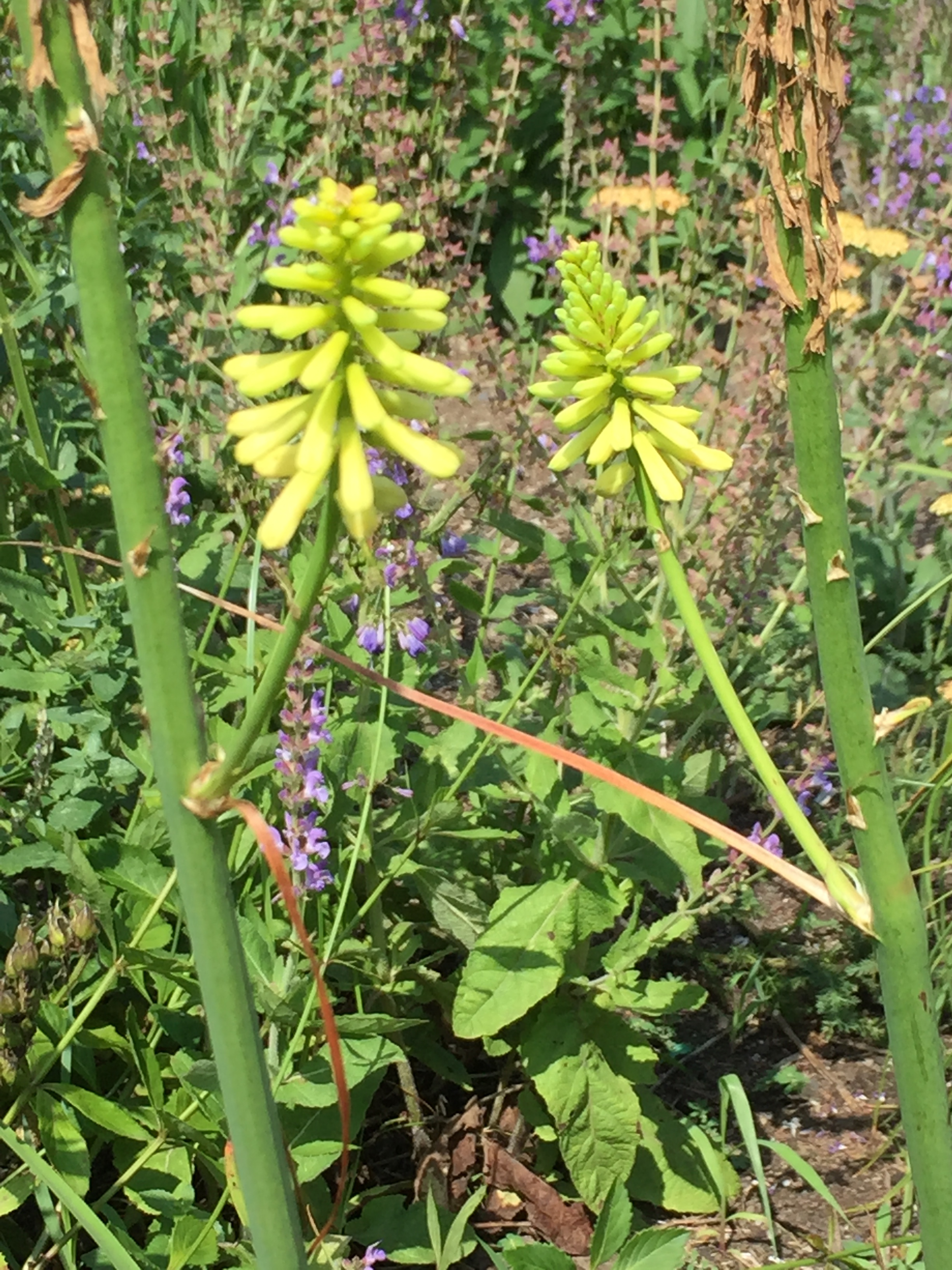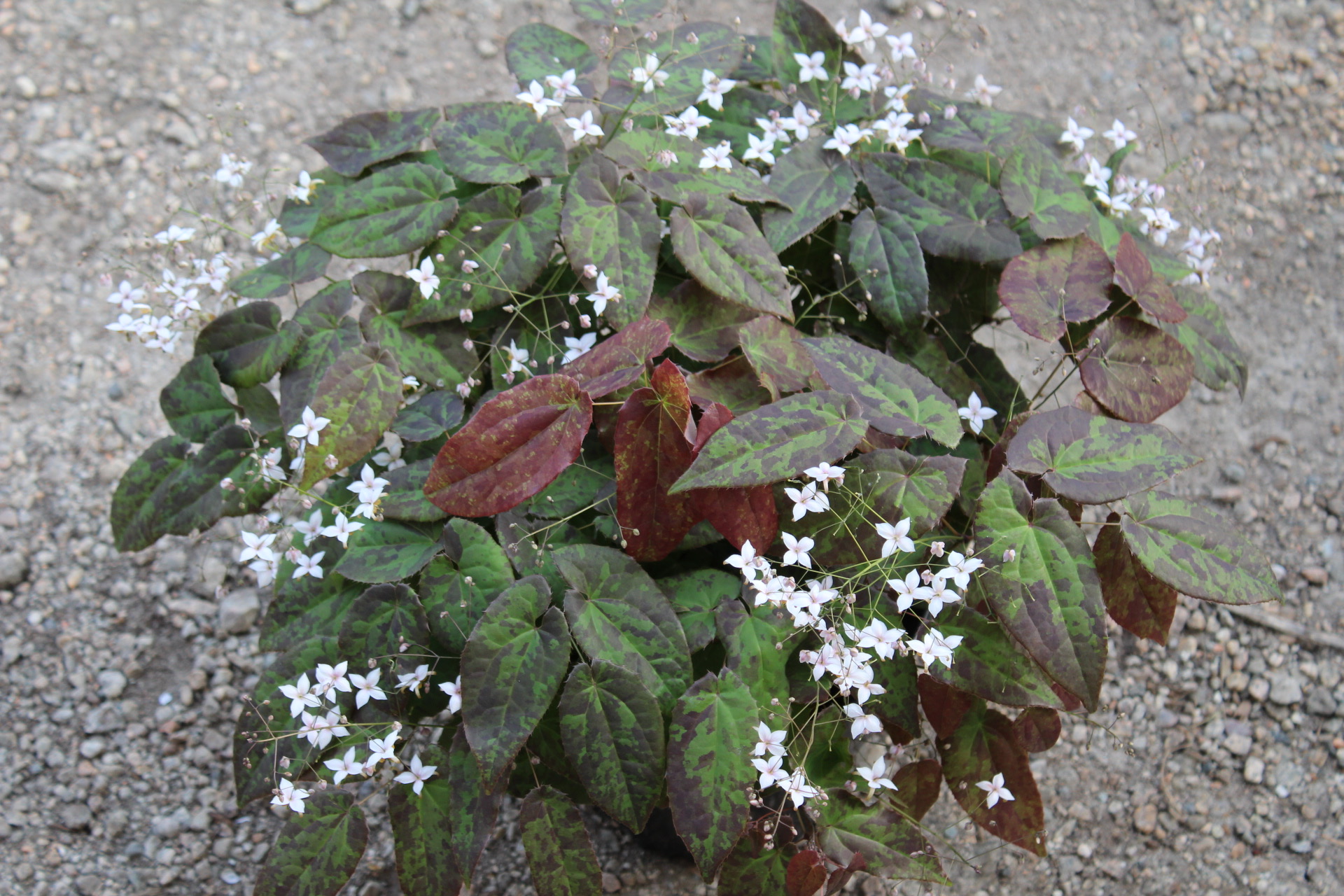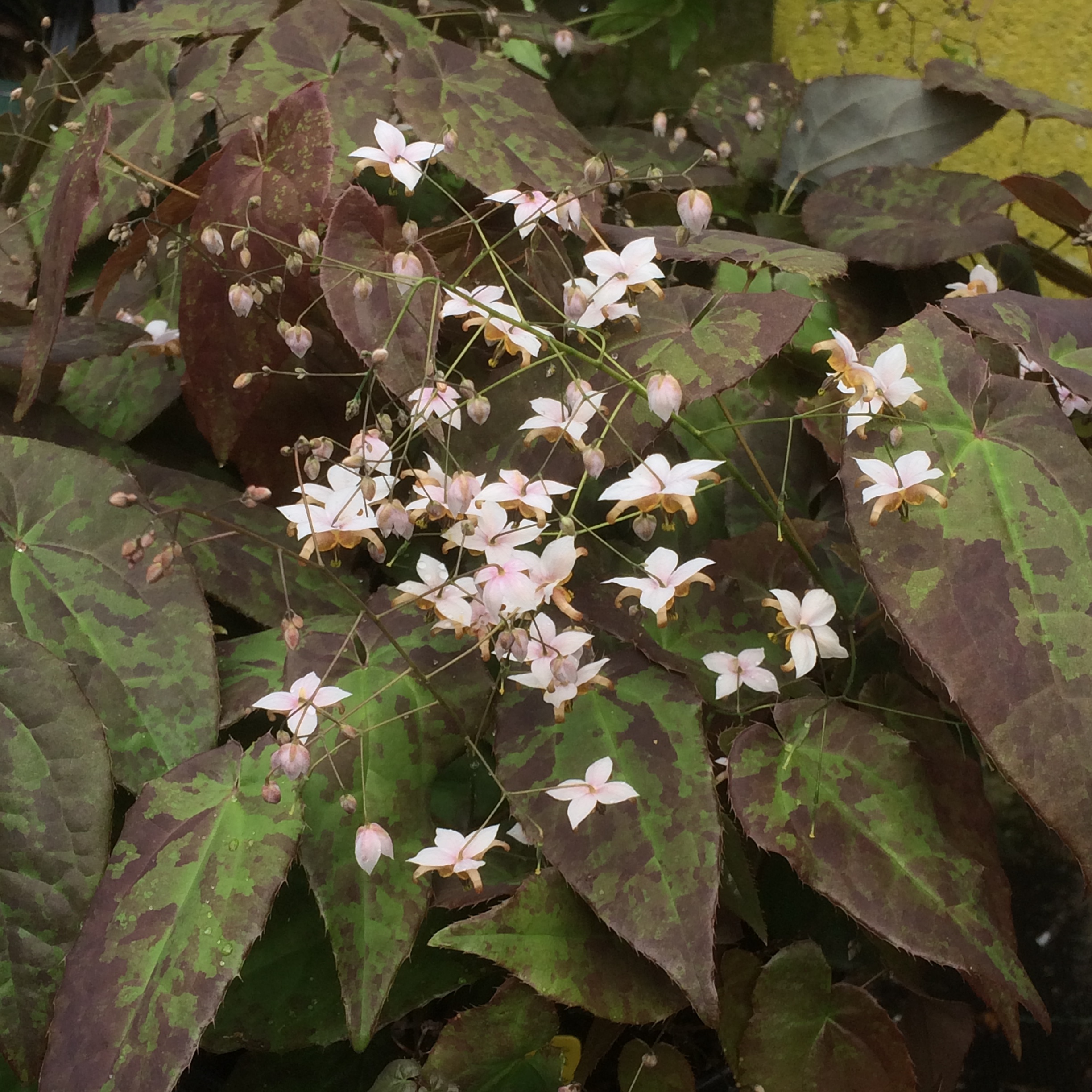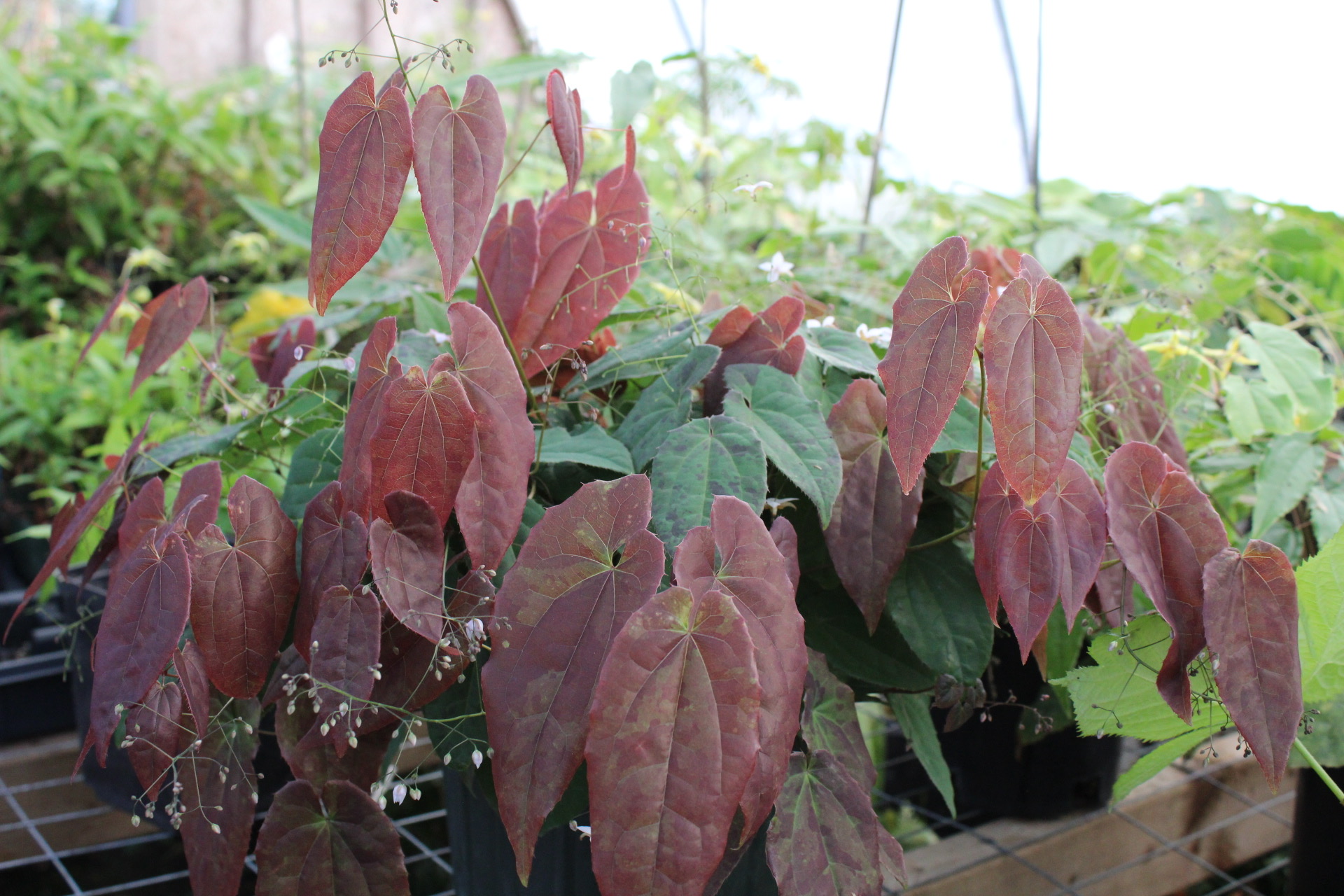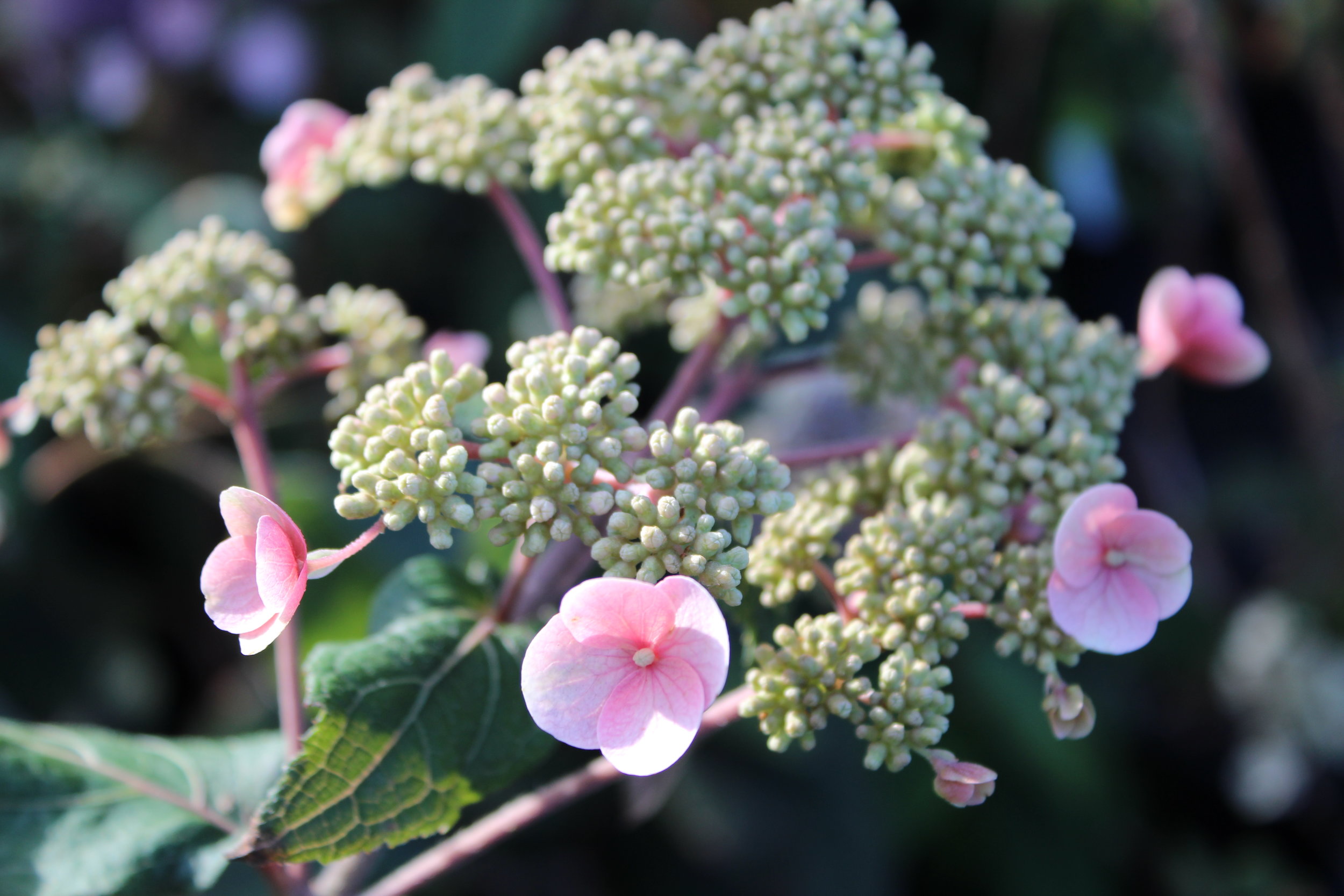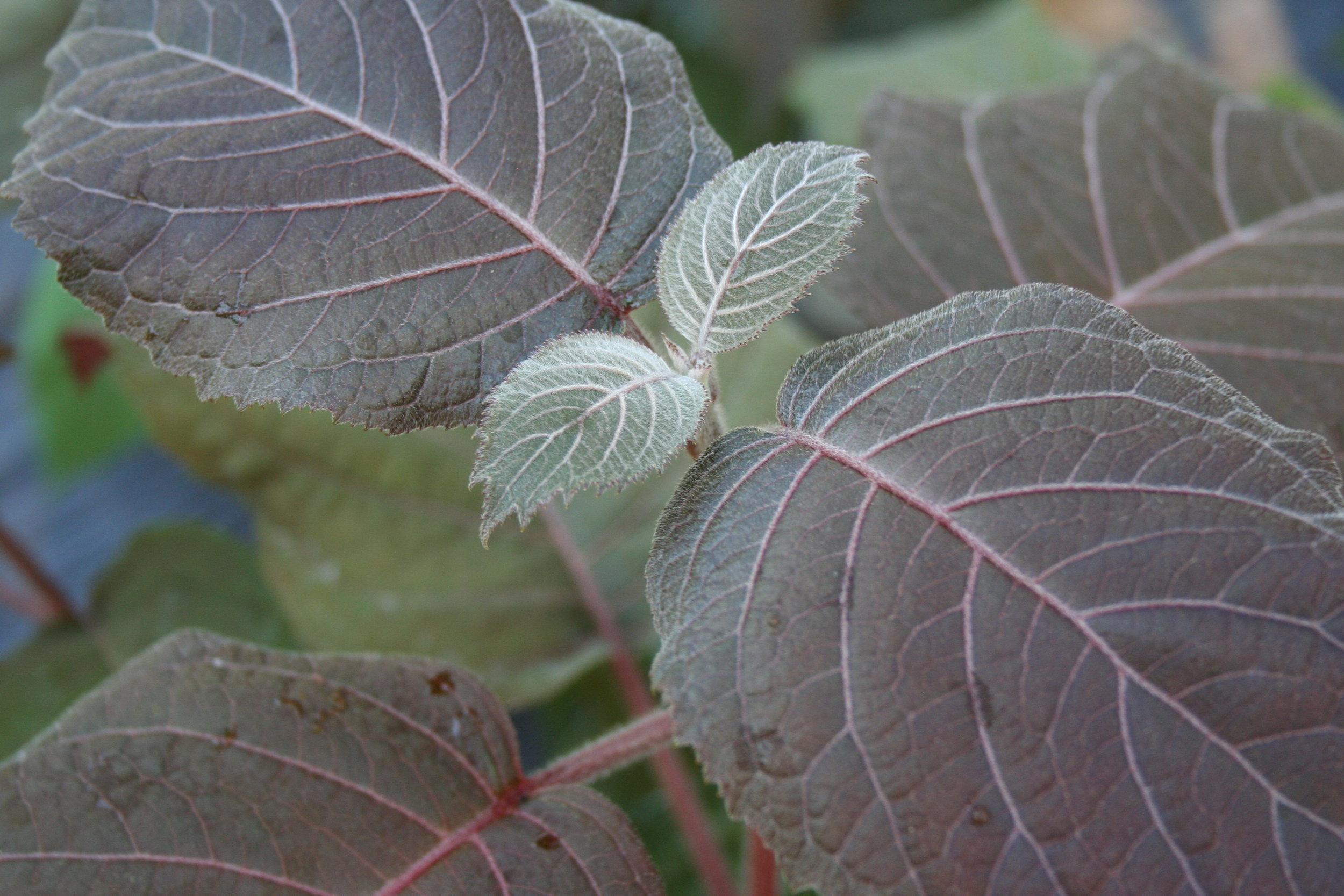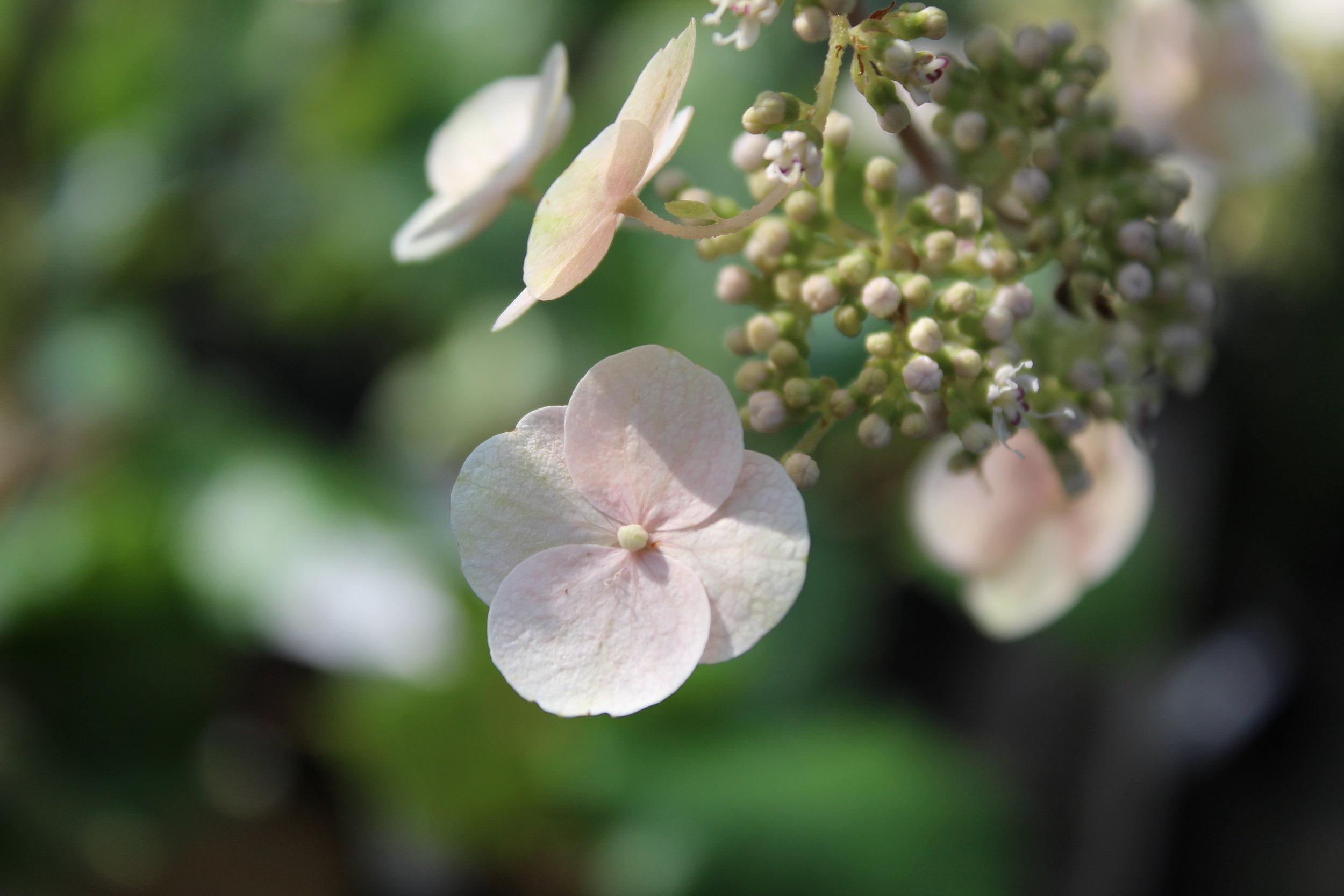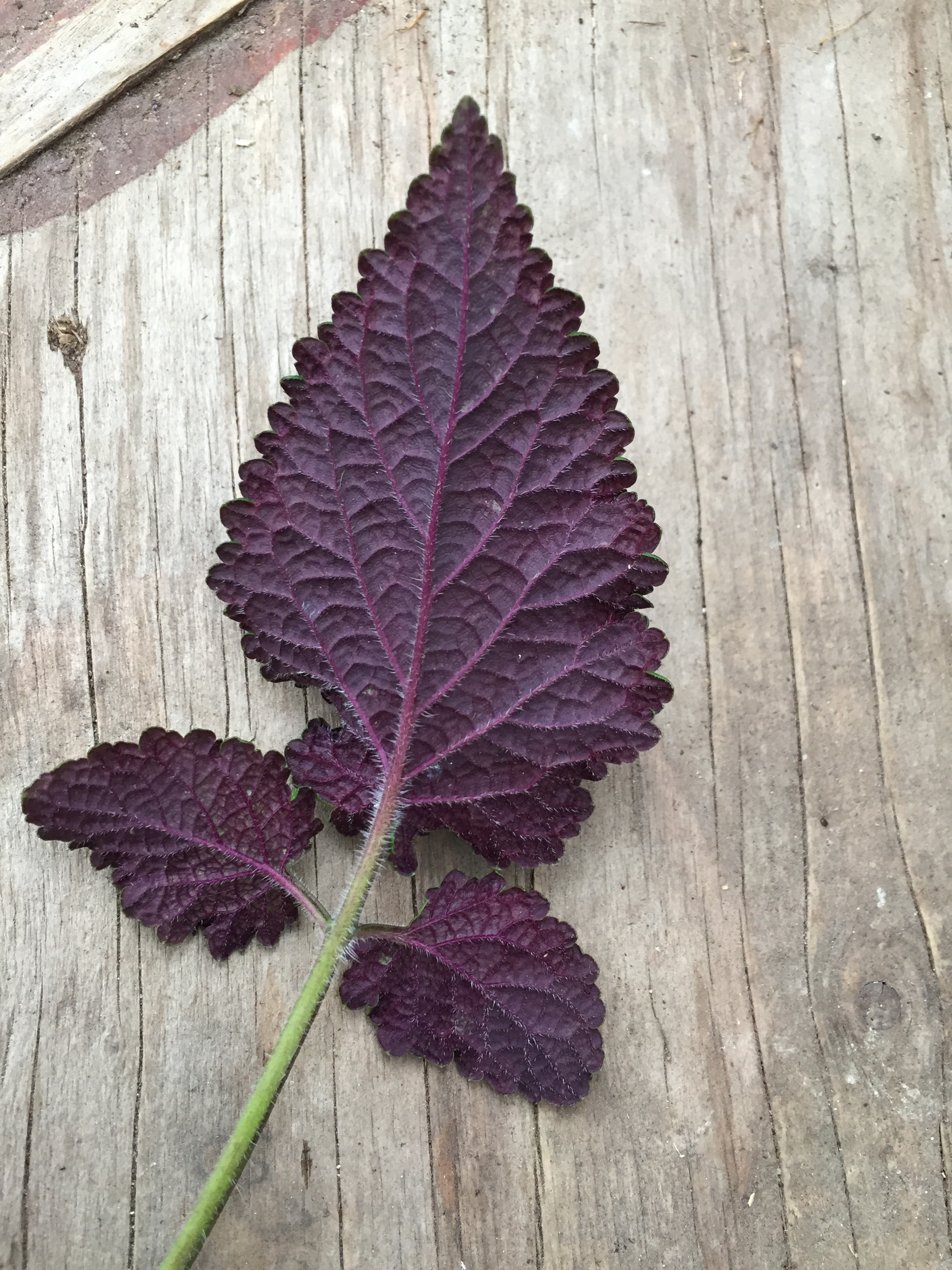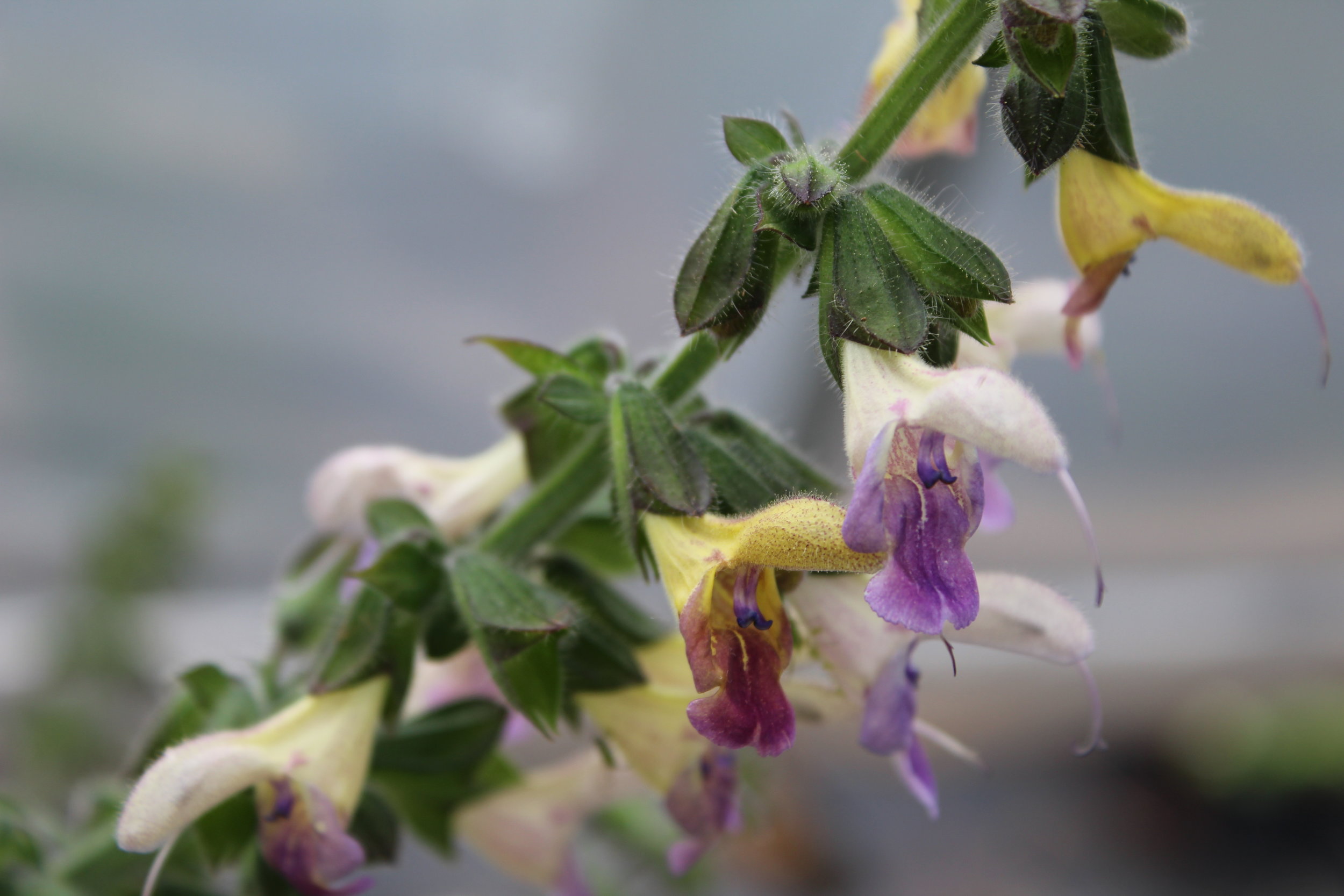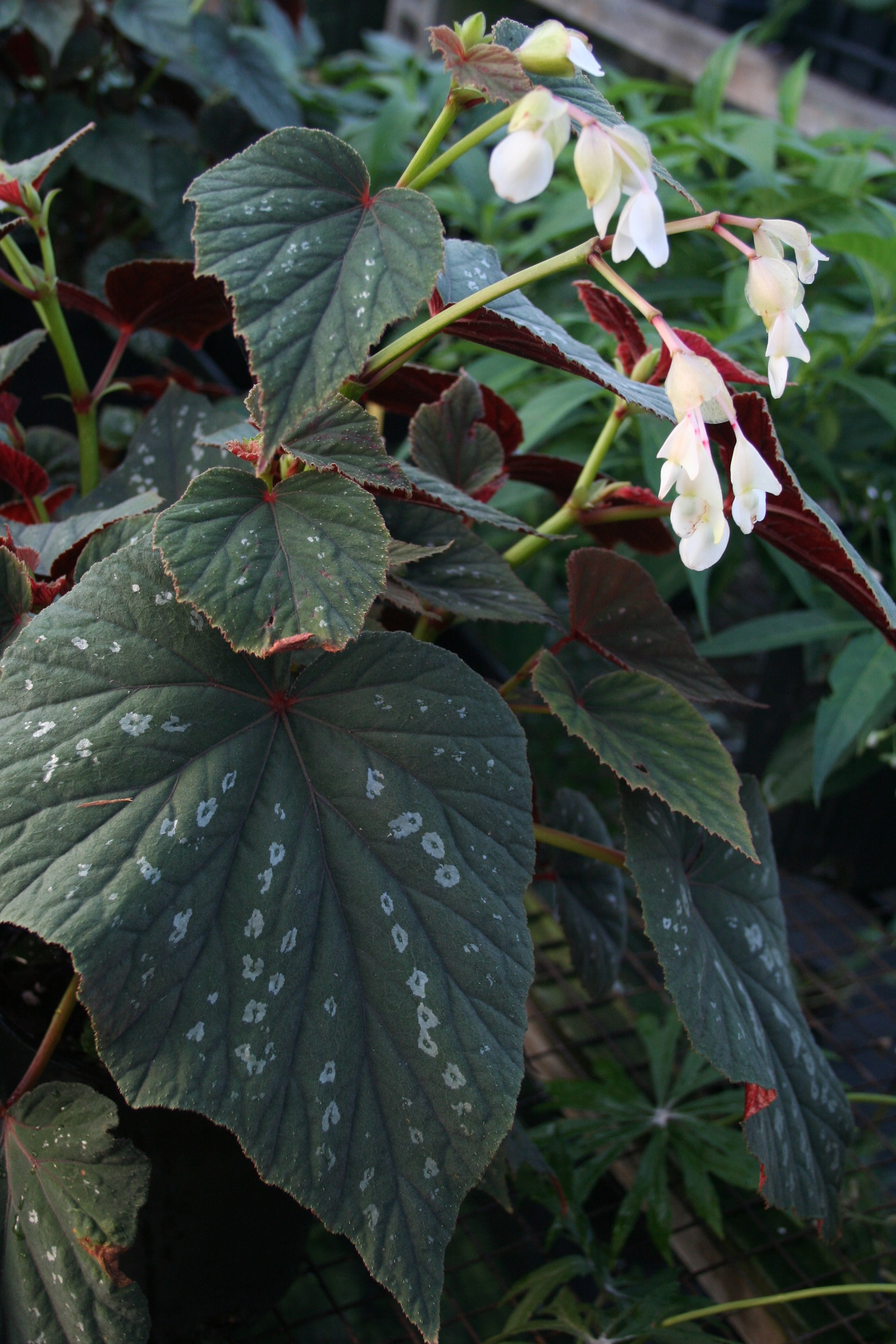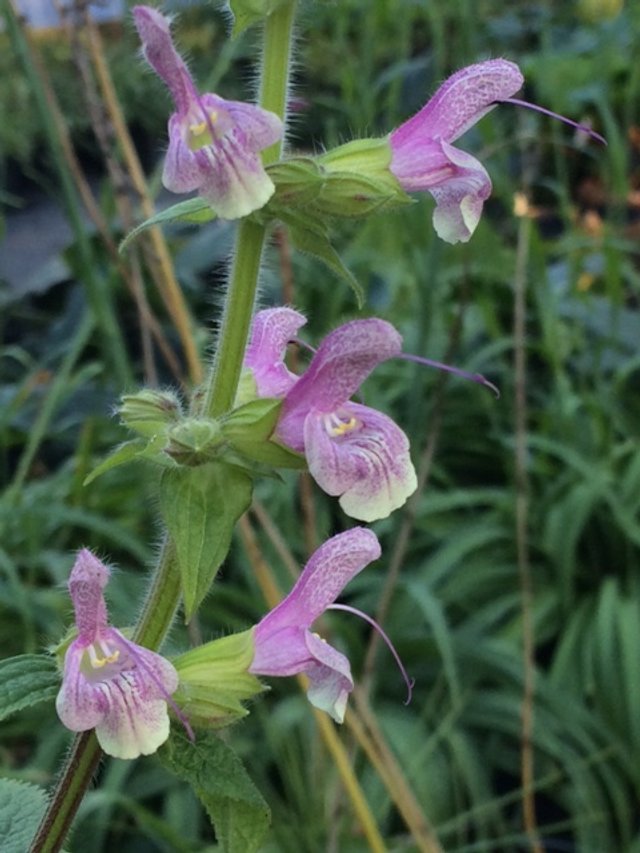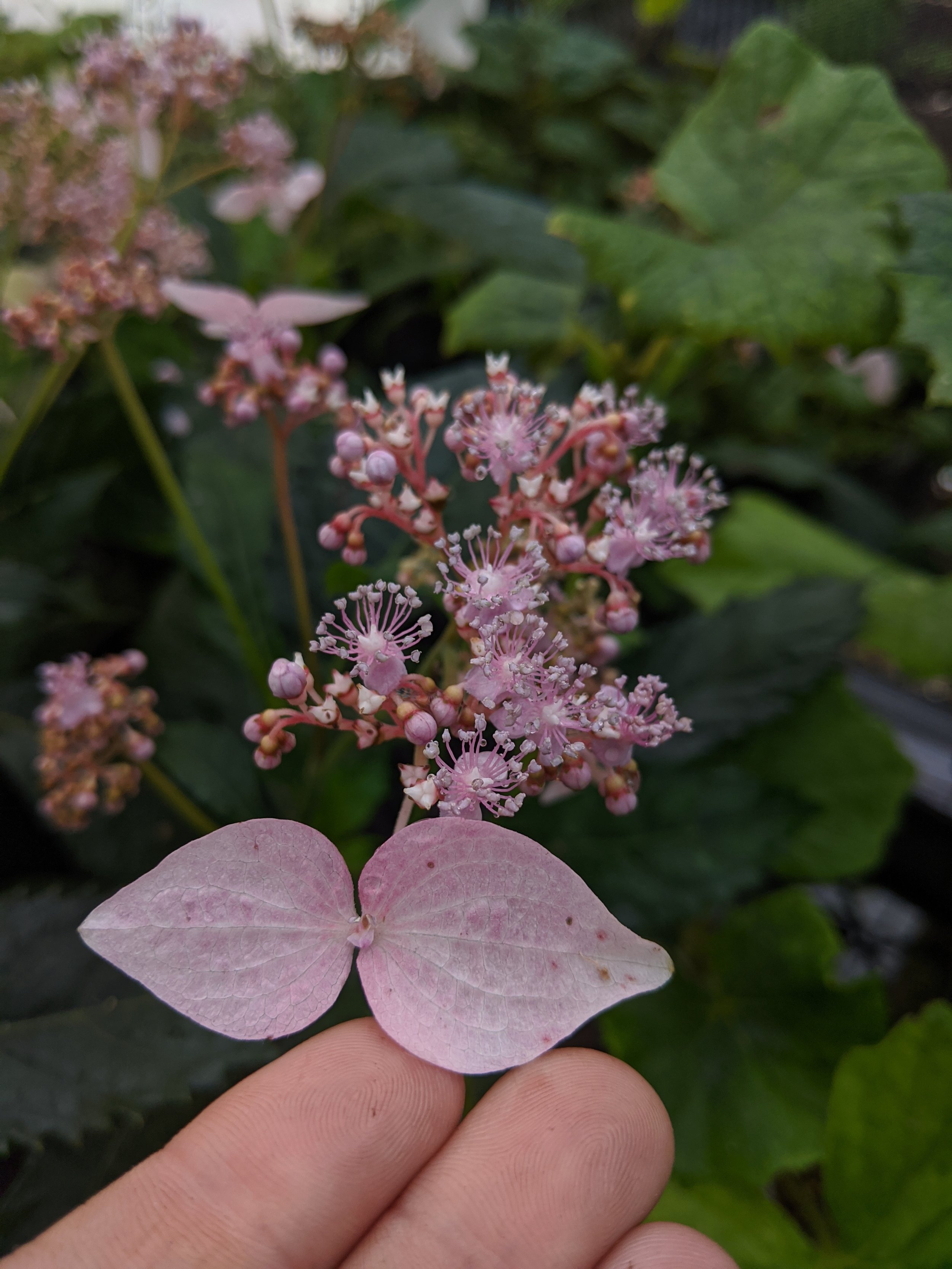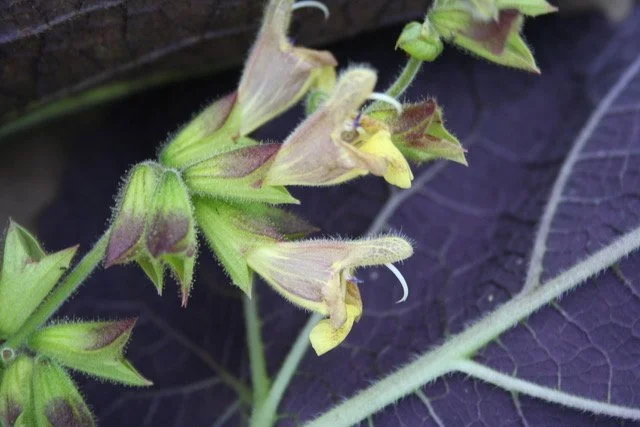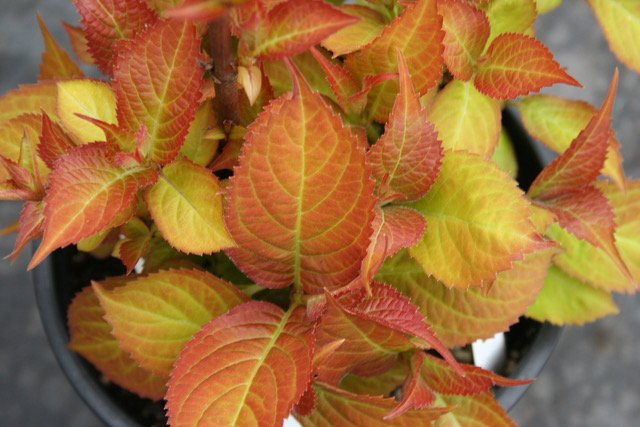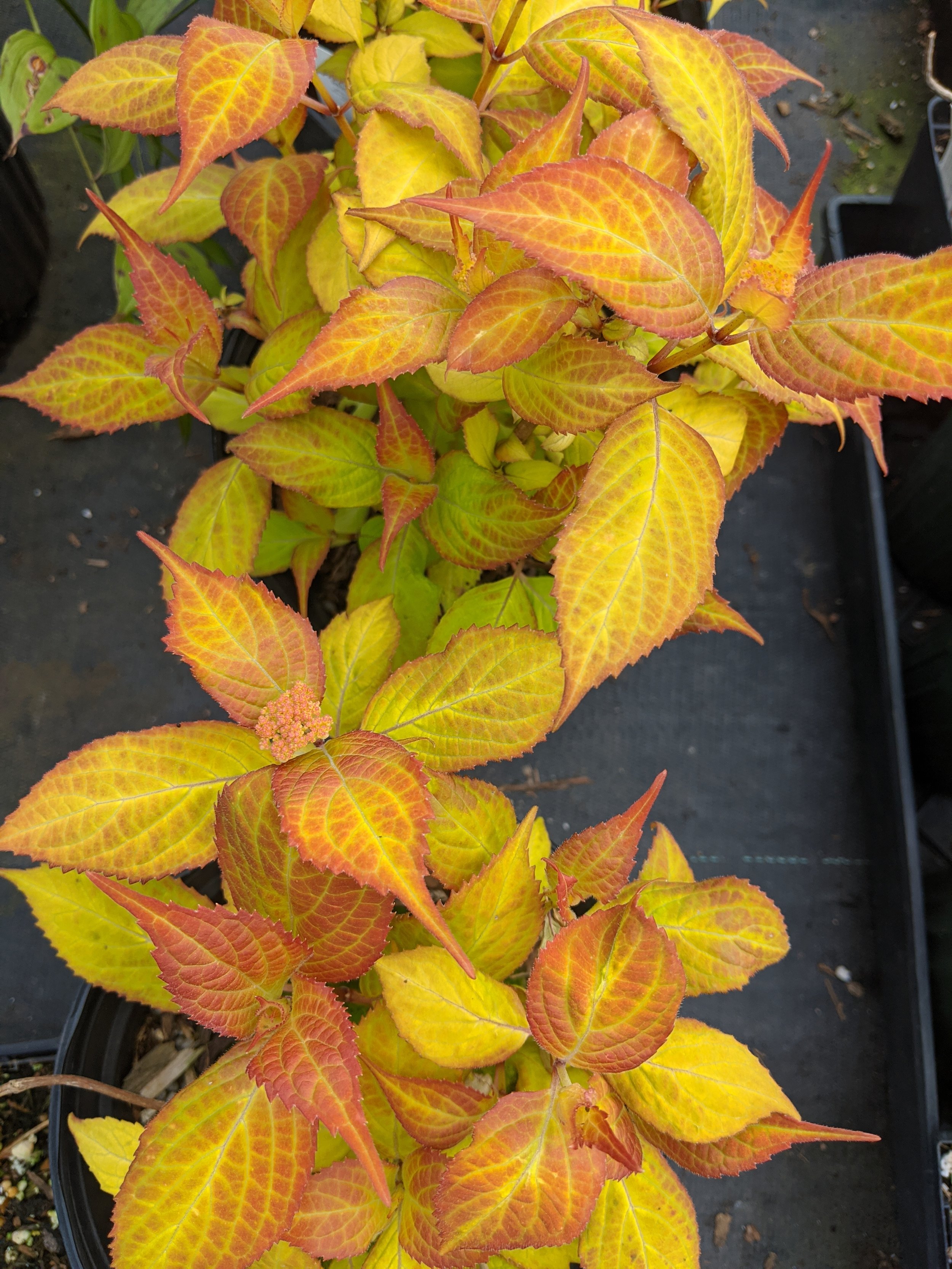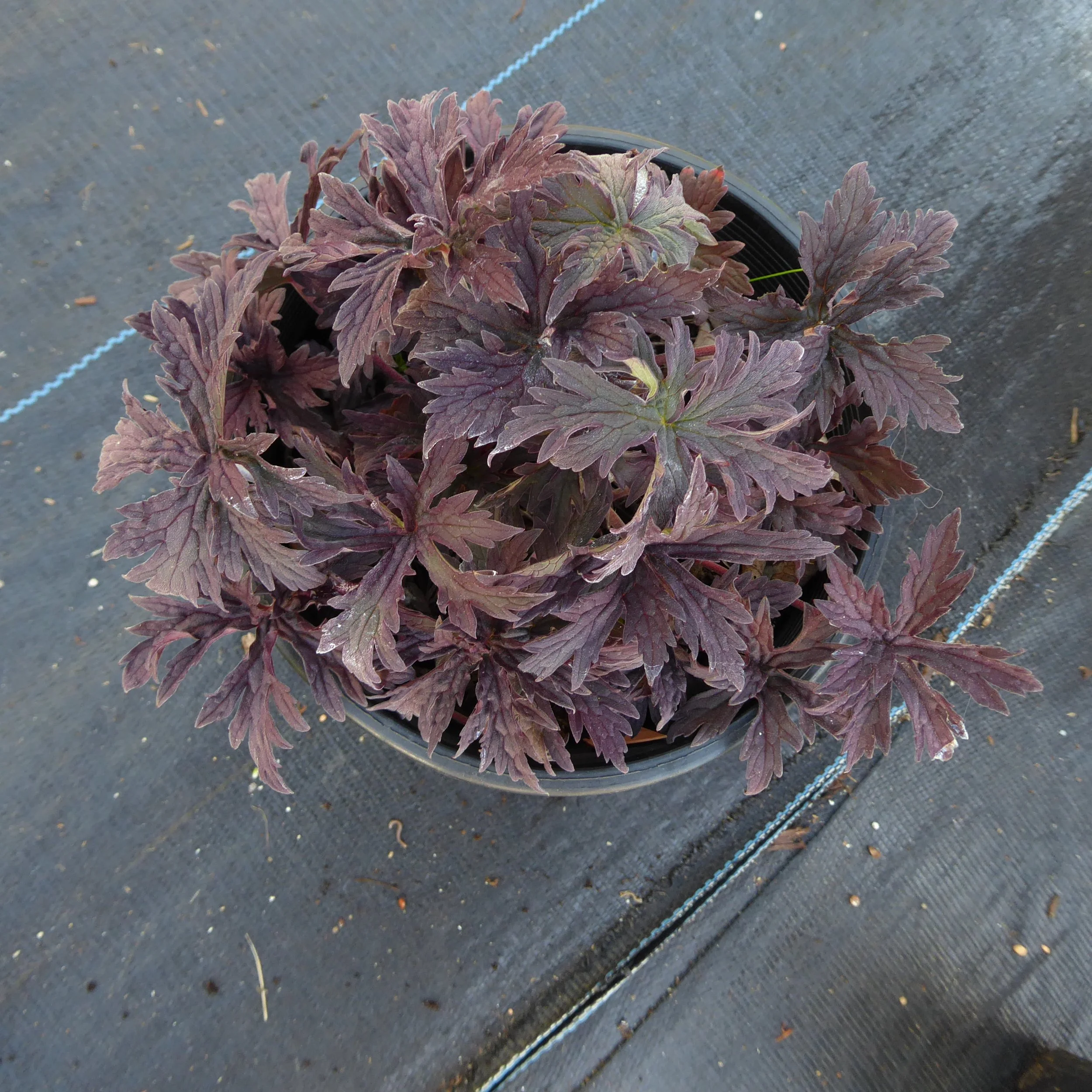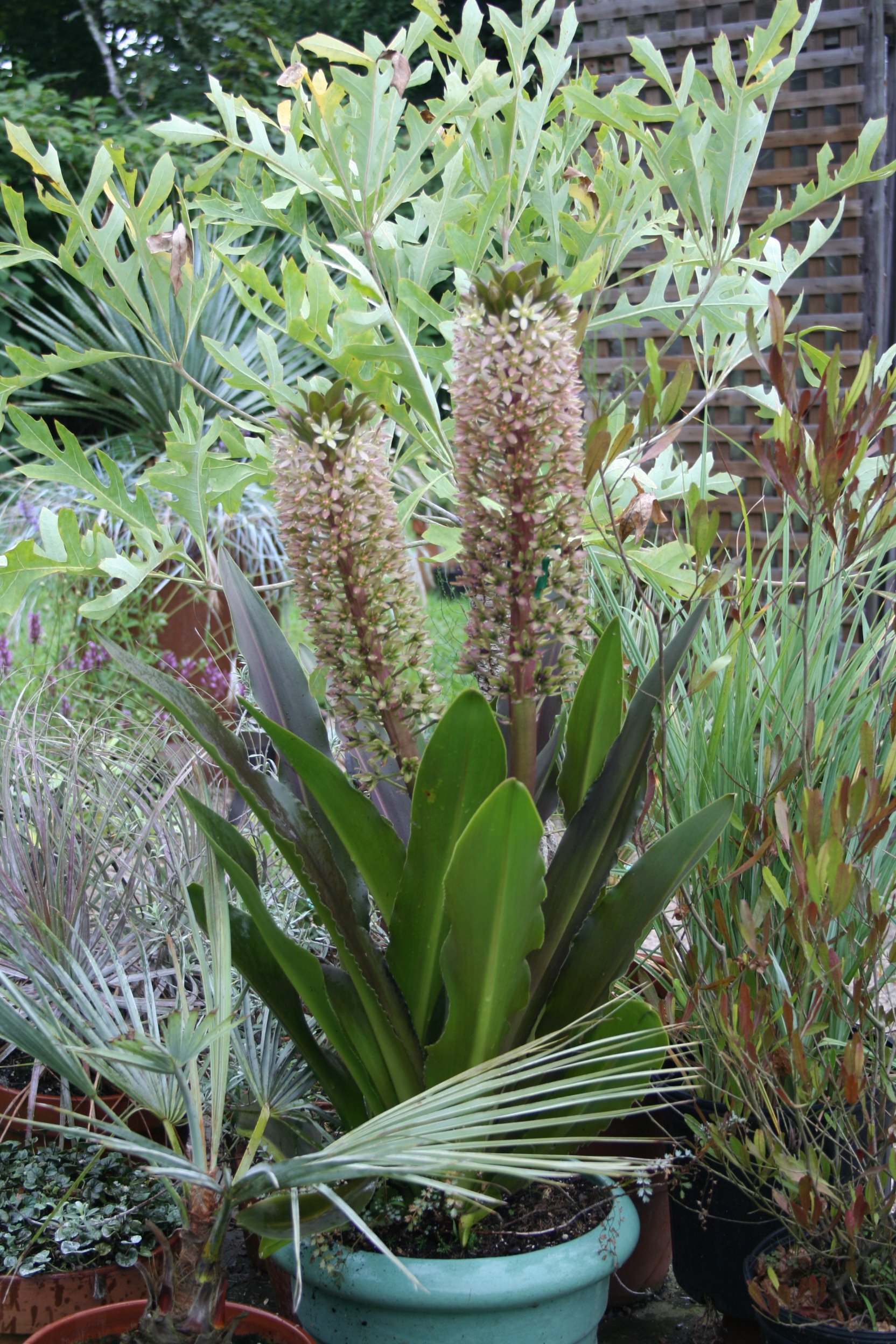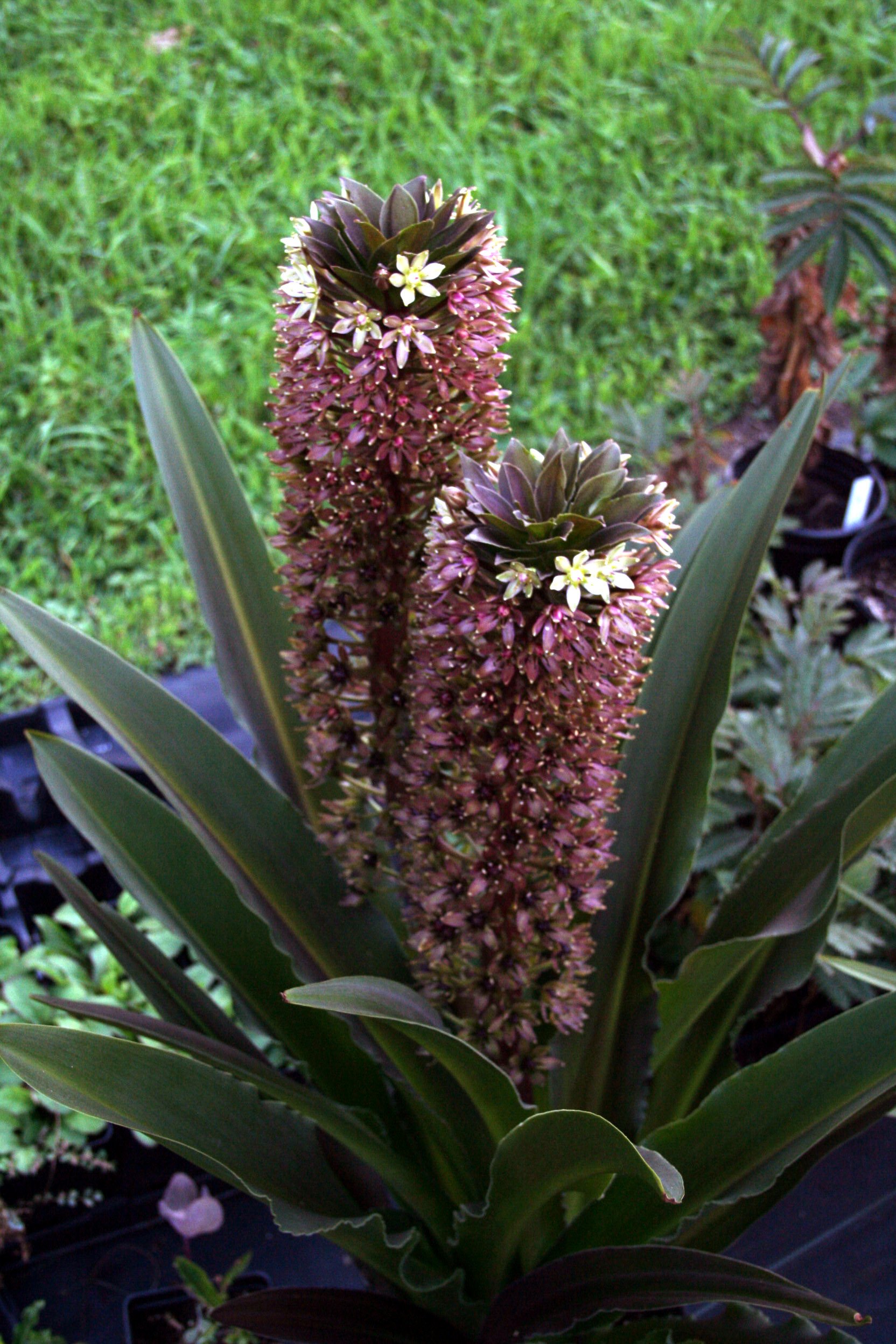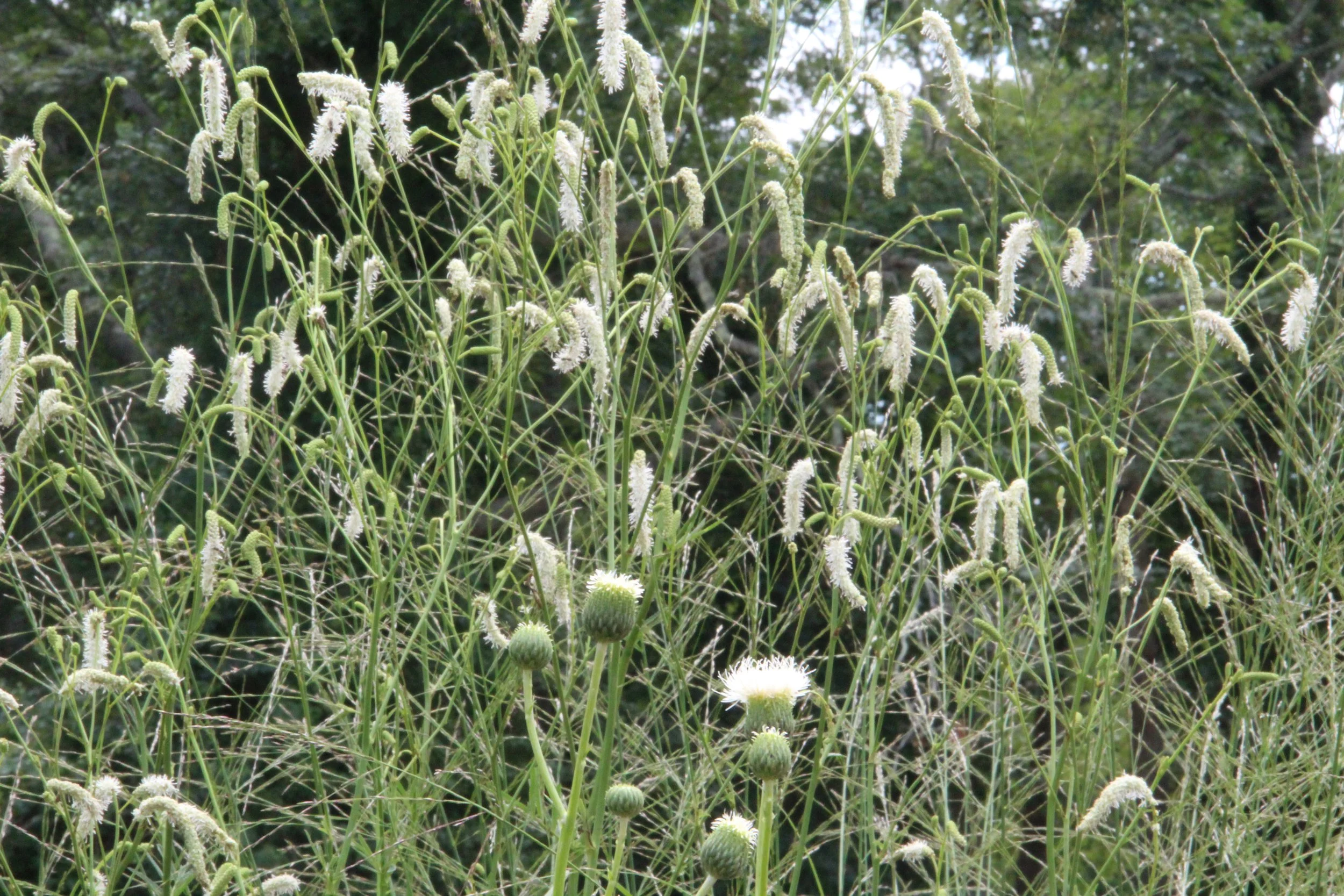A bit about our 2021 introductions (2022 & 2023 introductions to follow!):
(please scroll down for more & earlier introductions)
Syneilesis 'Horror Show'
This arose as a seedling more than a decade ago from crosses between palmata and aconitifolia, and we finally have enough to share a few with those variegate fetishists who’ve inquired. We are indebted to dear friend Aaron Bertelsen’s charmingly acerbic dismissal for providing us the perfect cultivar name! A slow, clump forming, filigreed seedling with chartreuse to green tie dyed leaves, which are especially strange and electric in spring. 15’x15’, Z5?
Chelonopsis moschta x yagiharana 'Stonewall Pink'
This is the offspring of a white flowered Chelonopsis moschata and C. yagiharana . 3’ black stems support a profusion of late summer, lavender pink tubes, becoming paler toward the lip. Hat tip to Dominique Browning for conjuring a name to honor both American history and lichen covered landscape vernacular… Easy in part sun/shade. Z5.
Epimedium ‘Giant Fire’
An in-house selection from our cross of ‘Windfire’ with ‘The Giant’. Spidery red and yellow spurs and smoky black stems of ‘Windfire’, but with larger flowers and much longer stems- 15-20”. Similar spread and semi evergreen habit as ‘Windfire’, but we’re guessing less hardy with the influence of ‘The Giant’ - Z6?
Centaurea - Naples Yellow
We’ve been sowing and lining out Centaurea for a few years looking for color breaks, and while we’re sure that this is a seedling of C. orientalis, we’re not precisely sure who the father is. Thanks to the book, ‘The Secret Lives of Color’, however, we now have the color vocabulary to describe the range of pale yellow tones found in this in-house seedling. The tasteful, gateway yellow for those who turn up their noses at the side of the highway color palettes of N. America. Z4, 3’ tall.
Syneilesis 'Tilt a Whirl'
As the name suggests, dynamic, undulating, multi tiered foliage on this new, 2021 introduction. Another seedling here from aconitifolia x palmata more than a decade ago. The leaf segments exist on almost two distinct planes and overlap, and the plant is distinctive, tidy and compact, slowly forming only a 1’ tall by 2’ wide mound.Z5?
Linaria ‘Pinky’
A seedling here from the putatively sterile ‘Peachy’ with deeper, pink, shading. To 24” x 30” Sun, Z6.
A bit about our 2020 introductions:
(please scroll down for more & earlier introductions)
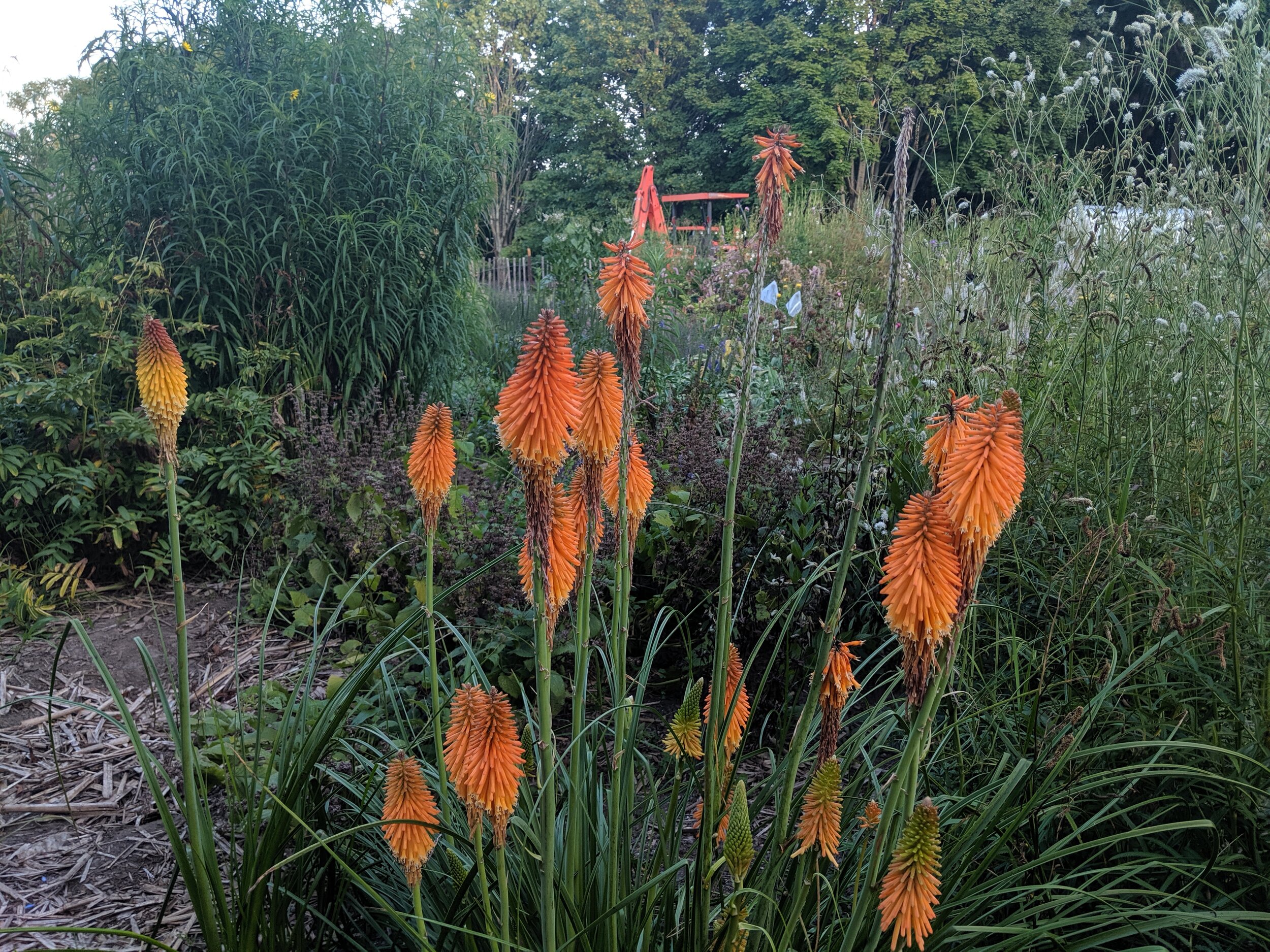
Kniphofia ‘Dries’
For those who prefer pudeur, this sibling to the outré but perpetually sold out ‘Wet Dream’ offers a similar effect without the blush. This saturated orange clone reads as solid orange, and slightly ombre when backlit. The name was suggested by a print from Dries Van Noten’s Fall 2019 ready collection, a print created from photographs of plants from the designer’s garden. Blooms August-September, 30 inches in flower.
Kniphofia ‘Corn Dog’
As the name suggests— chunky, sturdy infloresences on a stick, with tones of fried corn meal and mustard yellow, usher in the beginning of the state fair season (July). 32,’’ often repeat flowering in fall.
Kniphofia ‘Takis Fingers’
Flowering the exact shade of the telltale finger stain from enjoying this unnaturally neon, spicy snack. Like a perfect July BBQ in America, blooms concurrently with its ‘Corn Dog.’ 32,’’ often repeat flowering in fall.
Persicaria amplexicaulis ‘Ruby Woo’
There’s a reason we named this plant after the iconic MAC lipstick that famously looks good on everyone. A difficult-to-describe and singularly scarlet-rosenate color that amplifies just about any late season planting. Sturdy gently arching stems, with spotless green foliage.
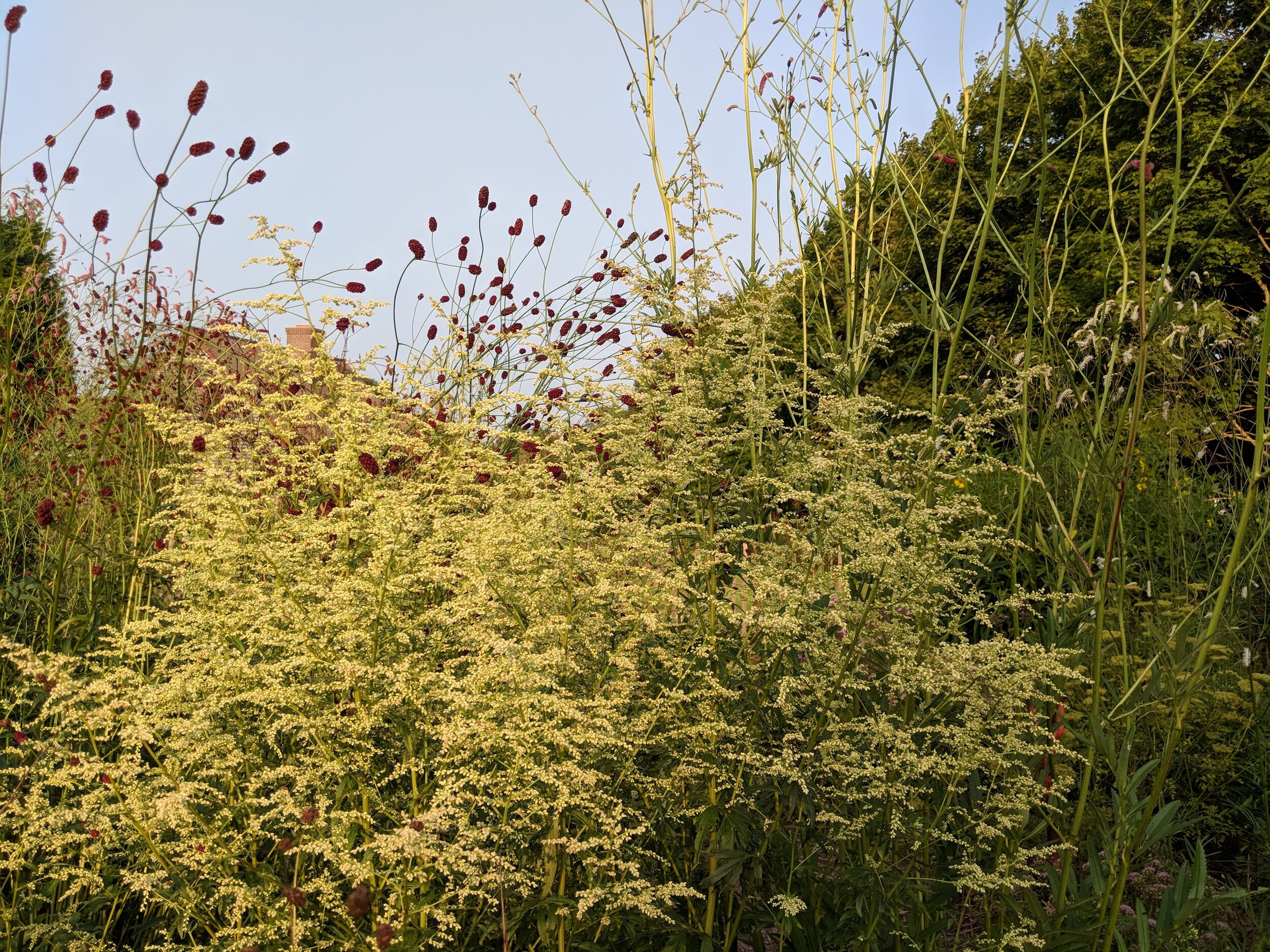
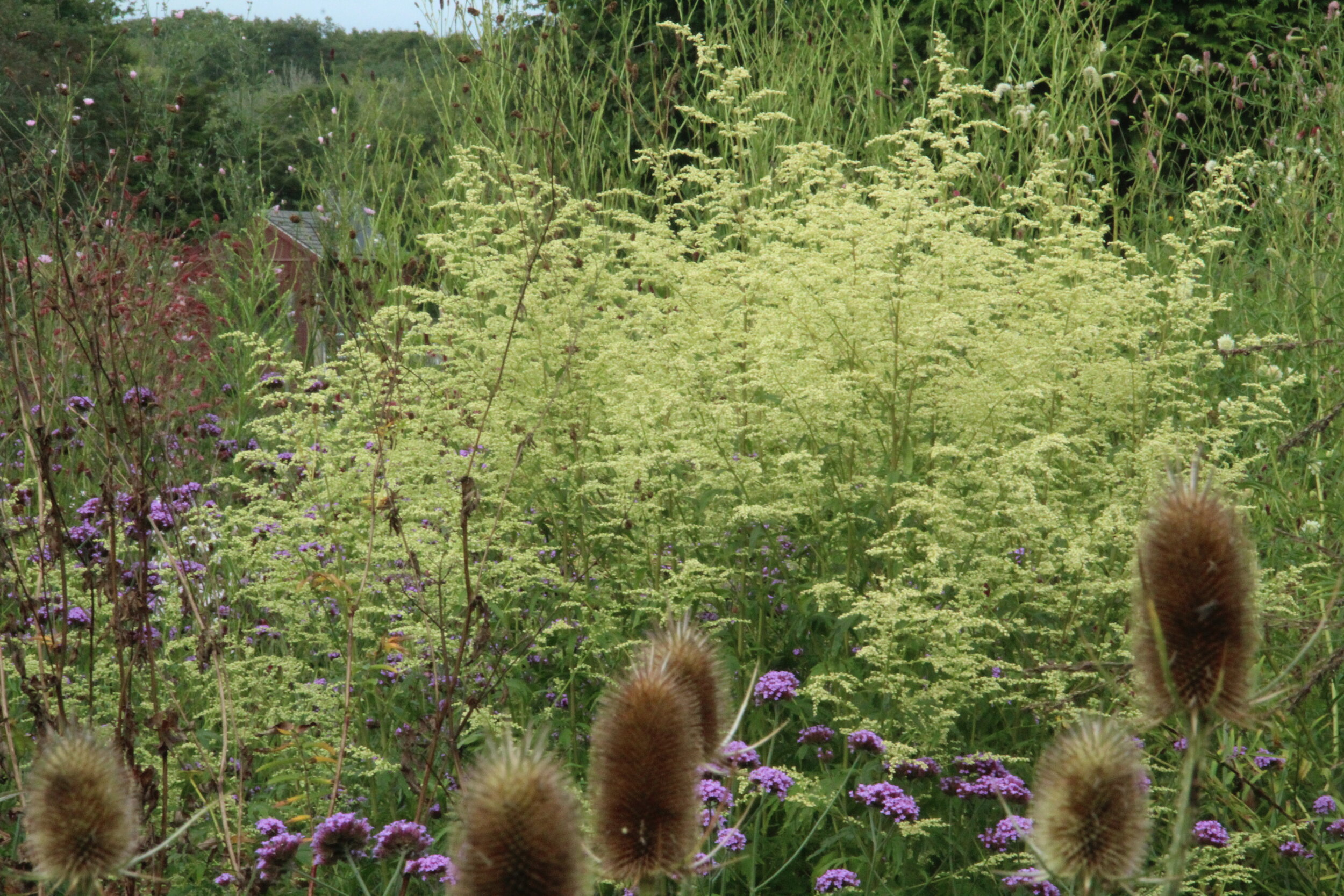
Artemisia lactiflora ‘Smoke Show’
Among thoughts that come to mind when thinking of Denver are vaping and Panayoti Kelaidis (though not necessarily in that order). We received this clone from Jan & Marty who grew it from seed from Panayoti when he still had Rocky Mountain Rare Plants. Gossamer inflorescences top stems reaching six feet, with pale emerald buds giving way to creamy white flowers, and easily grabs attention from July through November.
Sanguisorba obtusa ‘Tickled Pink’
A particularly plump flowered obtusa clone by way of Ellen Hornig via garden designer, Louis Raymond. Sturdy stems, and somewhat larger in the ground here than other obtusa (ca 3 ft). Flowers from early summer into summer.
Impatiens omeiana 'Black Ice'
Our seedling from ‘Ice Storm’, with leaves deeply flushed and red-backed on emergence, and the pale yellow flowers of its parent in autumn. 12”, Z6.
Sanguisorba ‘Unicorn Tails’
An hakusensis-esqe seedling we’ve been intending to propagate for some years now, but have needed a cultivar name. Check. It has a good, upright habit and flush brushes held horizontally and proud of the foliage on 4’ stems in early summer.
A bit about our 2019 introductions:
(please scroll down for more & earlier introductions)
Salvia glabrescens 'Lunar Blue'
Perhaps you missed the giggle inducing copy from The New York Times describing Lady Gaga’s Golden Globes gown as "lunar blue" rather than the seemingly obvious choice of periwinkle. Like nurseryman's blue, we can argue if this color is more lilac than blue, but can agree this color is a dramatic departure from the usual bi-color patternation typical of the species. Salvia glabrescens 'Lunar Blue' is a selection of a species we've long admired & been playing with from seed for years. She's a shade loving late bloomer --late Sept to Nov (depending where you are). This luminous color reflects blue to periwinkle as the fall sun tracks. Especially effective peppered (or carpeted, as shown on the red carpet) with scarlet Maple foliage. Averages 32 inches and hardy to at least Z5.
Podophyllum ‘Chinese Bronze’
(1401) Our cross of a whopping big versipelle and a heat tolerant delavayi. It’s a big plant, to 3’, and has proved vigorous and durable. First year we’ve offered, and those that are left are small but sturdy. More for autumn. We’ll also have a half-sized version of this available soon. Z6
Hydrangea ‘Saturnalia’
The only plant of garden interest produced thus far from many dozens of seedlings and a few years of chasing the intriguing possibilities presented by hybrids between H. serrata and H. scandens/angustipetala. A pink picotee rings the huge, elliptical, white sepals of the sterile florets, and foliage is durable, tardily deciduous ( near evergreen in frost-free areas), deeply flushed red on new growth, and again in autumn with cooler temperatures. Flowers from old wood in late spring, with a habit that's upright. Height likely around 3' (height of original, though likely taller in warmer climes) and hardiness somewhere in Z6, we'd guess. Best with some shade.
Hydrangea aspera ‘Red Velvet’
Like a red foliage version of aspera 'Macrophylla' . Foliage fades to deep olive for the summer, but maintains pigment on leaf underside. Truly distinctive and certainly the most beautiful red leaf aspera of any of the hundreds we've grown from seed. (Ed fell asleep halfway through this description so Taylor finished).
A bit about our 2018 Introductions:
(please scroll down for more & earlier introductions)
Platycrater arguta ‘Honey Moon’
The estimation of many genera rests upon the single clone of it that is in cultivation. Platycater has been consigned to a sleepy, of botanical interest only reputation, based on the small flowers of the usual form. Largely unknown are forms with pink flowers, fragrant flowers, and large flowers. ‘Honey Moon’ is a charmed seedling from the fragrant, large flowered cv. ‘Kaeda’, inheriting the perfume, but with flowers thrice as large.
Podophyllum ‘Shade Brocade’
‘Spotty Dotty’ is a wonderful plant, suffering from but two problems: its patent and often limited availability. ‘Shade Brocade’ is ‘Spotty’ crossed back to delavayi. Smaller in stature but with similar leaf markings, it removes the patent issue and allows us to propagate, but will be in short supply in the immediate future.
Hydrangea aspera ‘Royal Lace’
A tough, hardy, clone that to date has been unhelpfully been sold here as “1401”, but demands something less clinical. A seedling from a plant which was itself a cross of subspecies villosa and subspecies sargentiana, its luxurious foliage has been Americanized and is large, with nicely pigmented, indigo fertile flowers orbited by lots of white sepals. (Cf it’s all about the sepals).
Epimedium ‘Patent Assasin’
We’ve been puzzling how, at a glance, to distinguish E. ‘Spine Tingler’ and E. ‘Ninja Stars’ for some time (in brief, ‘Ninja Stars’ runs, and ‘Spine Tingler’ doesn’t), and apparently we’re not the only, as the two have become confused in commerce. Though European sources have finally corrected the cv name from ‘Sphinx Twinkler’, they have been sending the excellent but patented, ‘Ninja Stars’ as ‘Spine Tingler’, which adds to the domestic disturbance, especially as ‘Ninja Stars’ is a patented plant. ‘Patent Assasin’ derives from a cross of ‘Ninja Stars’ (which we originally received as wushanse!) and ‘The Giant’, is virtually indistinguishable from the foregoing, with similar mahogany flushed foliage and spidery yellow flowers, runs, is patent free for open source propagation, and hasn’t (yet!) been sold under a wrong name.
Kniphofia ‘Sideshow Bob’
An open pollinated seedling of Kniphofia fibrosa that has proved hardy, floriferous, and features branched inflorescences, a feature that while not unknown in the genus is unusual. Easy to mix lemon yellow pokers in June with later rebloom.
Epimedium ‘Wine Spritzer’
Our seed sowing enthusiasm has extended to the manifold charms of the genus Epimedium. In deference to friends Darrell Probst and Karen Perkins, we’ve thus far skirted the commercial end, but make an exception here, as this plant is distinctive enough to merit a name. Resulting from a cross between accuminatum and borealiguizhouense, it sports multiple new flushes of growth, each heavily stippled, streaked and saturated claret, with accompanying profusions of small, white, seemingly sterile flowers. Spreading. Name in keeping with other vinous variants out there, and commemorating T’s fave effervescent elixir.
Hydrangea sikokiana x aspera ‘Smoked Salmon’
The Japanese species Hydrangea sikokiana offers lobed foliage not unlike our native H. quercifolia, but problematically has a nearly sepal-less inflorescence the color of dust. We’re still playing the numbers game with this combo, but this is an interesting intermediate, with lobed, purple saturated foliage and flowers in pale salmon with more sepals than the usual. In addition to referencing the color, the name is as a geographic tag and friendly taunt to one inspirational Hydrangea fancier in the Pacific Northwest. You know who you are!
Hydrangea aspera ‘Royal Flush’
Mikinori Ogisu’s collection of a red leaf aspera in the wild (can you imagine the luck?!) has added color to the species existing, manifold charms of elegant flower, sumptuous foliage, and sinuous, exfoliating stems. As ever and elsewhere, we’ve been at play with it from seed and have grown out many hundreds over multiple generations and crosses. Abecedarian wise, this the is the first of our red foliage plants to be named, and though perhaps similar to ‘Hot Chocolate’ and ‘Burgundy Bliss’/‘Plum Passion’, (certainly as compared to other, decidedly distinctive red foliage ones we are and/or will be introducing), we think this has advantages in increased hardiness (usual references are wrong about this species anyway) and better flowers-- it’s always about the sepals, and these are more numerous and deeply pigmented.
Salvia ‘Harlequin’s Trident’
Add entry, repeat methodology: Salvia omeiana ‘Crug Thunder’ is a wonderful foliage plant for shade, but short lived. Crossing it over the years has led to more durable, larger, longer- lived hybrids, and we’re not through yet. This is an unlikely fusion of it with the obscure, pinnate, Salvia bowleyana, with compound foliage purple on the reverse, and complimentary colored flowers, opening butter yellow and quickly fading to buttermilk with purple nectary guides.
A bit about our pre-2018 Introductions:
(please scroll down for more & earlier introductions)
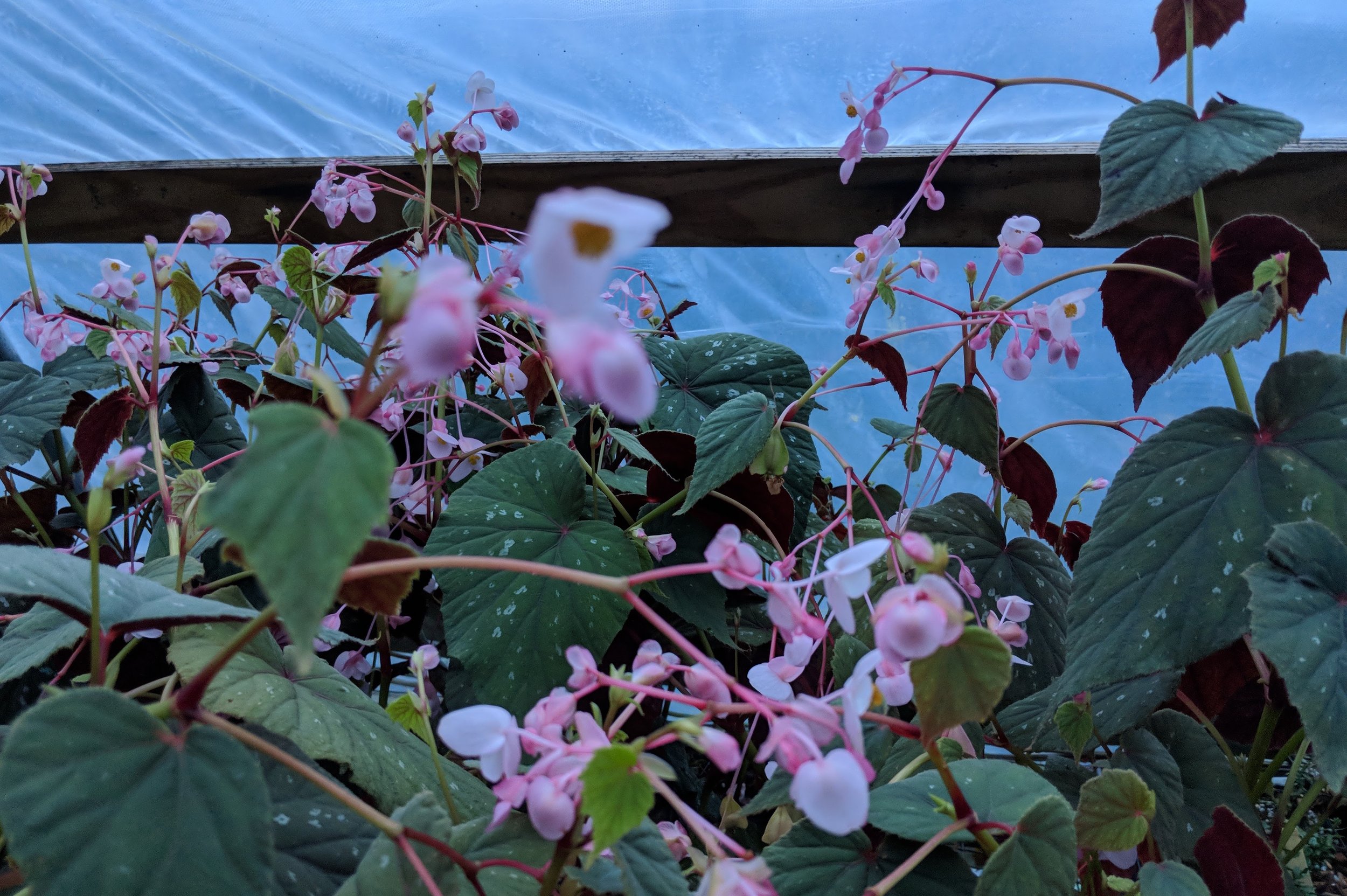
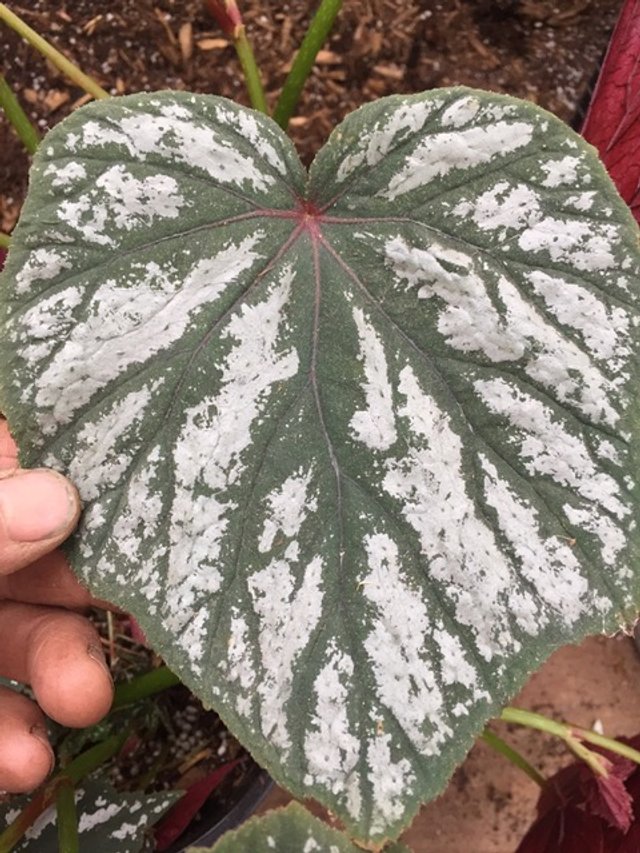
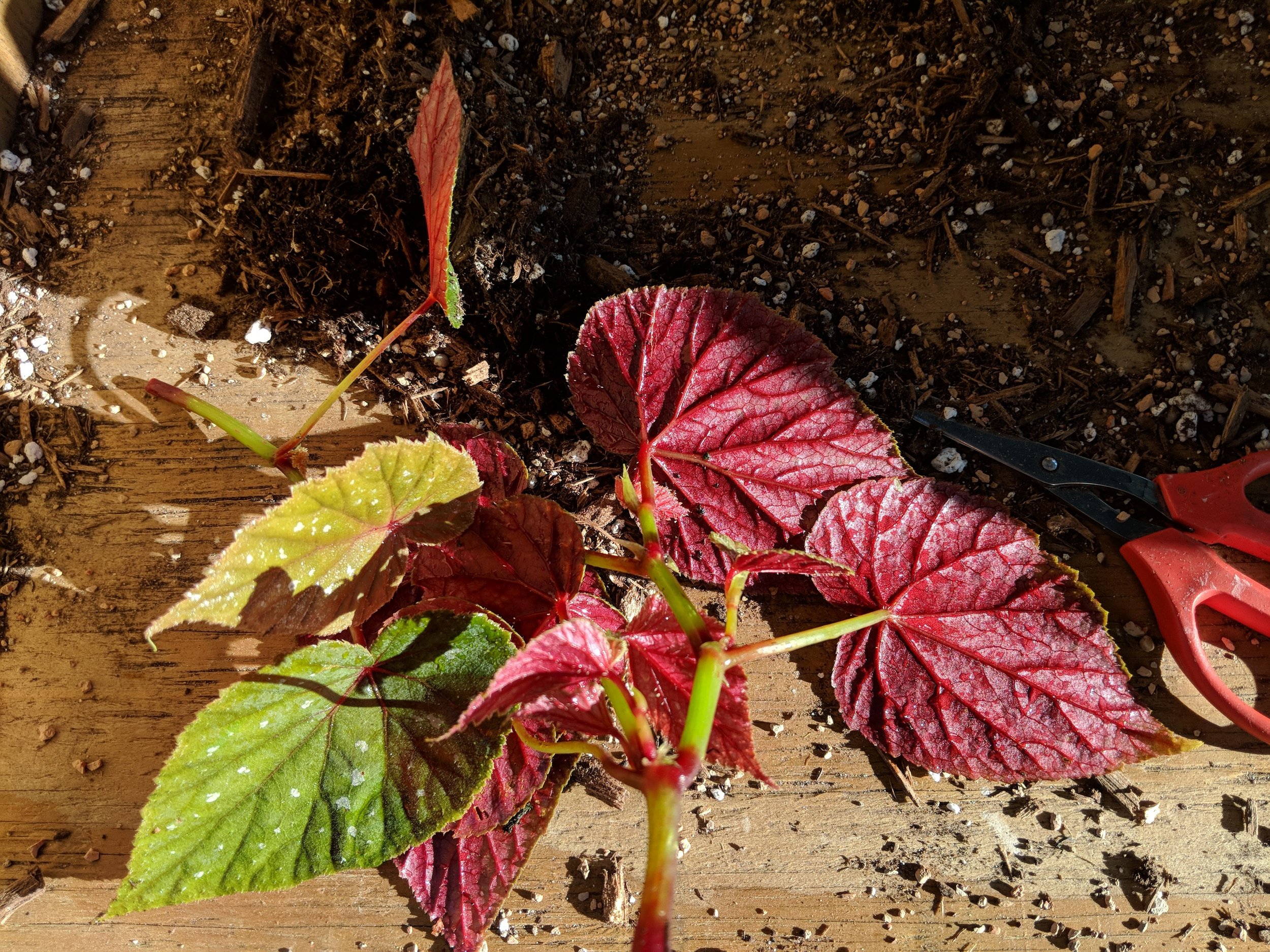
Begonia grandis 'Bells and Whistles'
Hardy tuberous species, easy in shade and well drained soil with adequate H20 during the growing season. This seleciton from an in house cross. Deepest oxblood leaf reverse with silver spots above and pink flowers. Best leaf patternation in shade. Flowering stems 12-15”, Z6. Late to emerge and spreads by bulbils.
Begonia grandis 'Sparkle and Shine'
Hardy tuberous species, easy in shade and well drained soil with adequate H20 during the growing season. This seleciton from an in house cross. Deepest oxblood leaf reverse with silver spots above and white flowers. Best leaf patternation in shade. Flowering stems 12-15”, Z6. Late to emerge and spreads by bulbils.
Salvia ‘Autumn Tryst’
An in house hybrid of glabrescens and glutinosa with a profusion of pink and yellow flowers over many weeks in autumn, and an outstanding habit-sturdily upright to 3’or so. Easy in shade to part shade, though a bit more sun tolerant than pure glabrescens. Z5.
Bergenia pacumbis 'Green Monstah'
Our huge sized selection of this deciduous species with white fading to pink flowers in spring, but this is primarily a foliage plant, as the flowers are followed by huge (12+”) leaves. Best with some shade, and summer water. Hardy to Z5
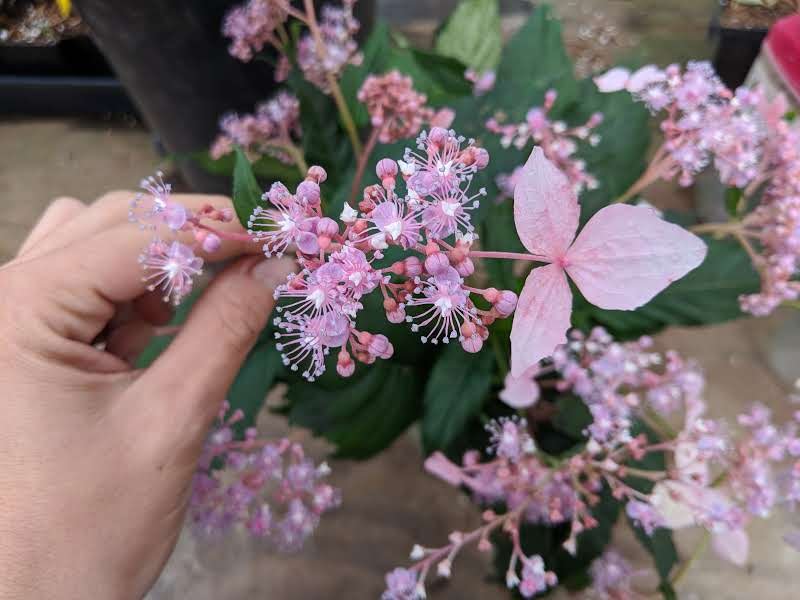
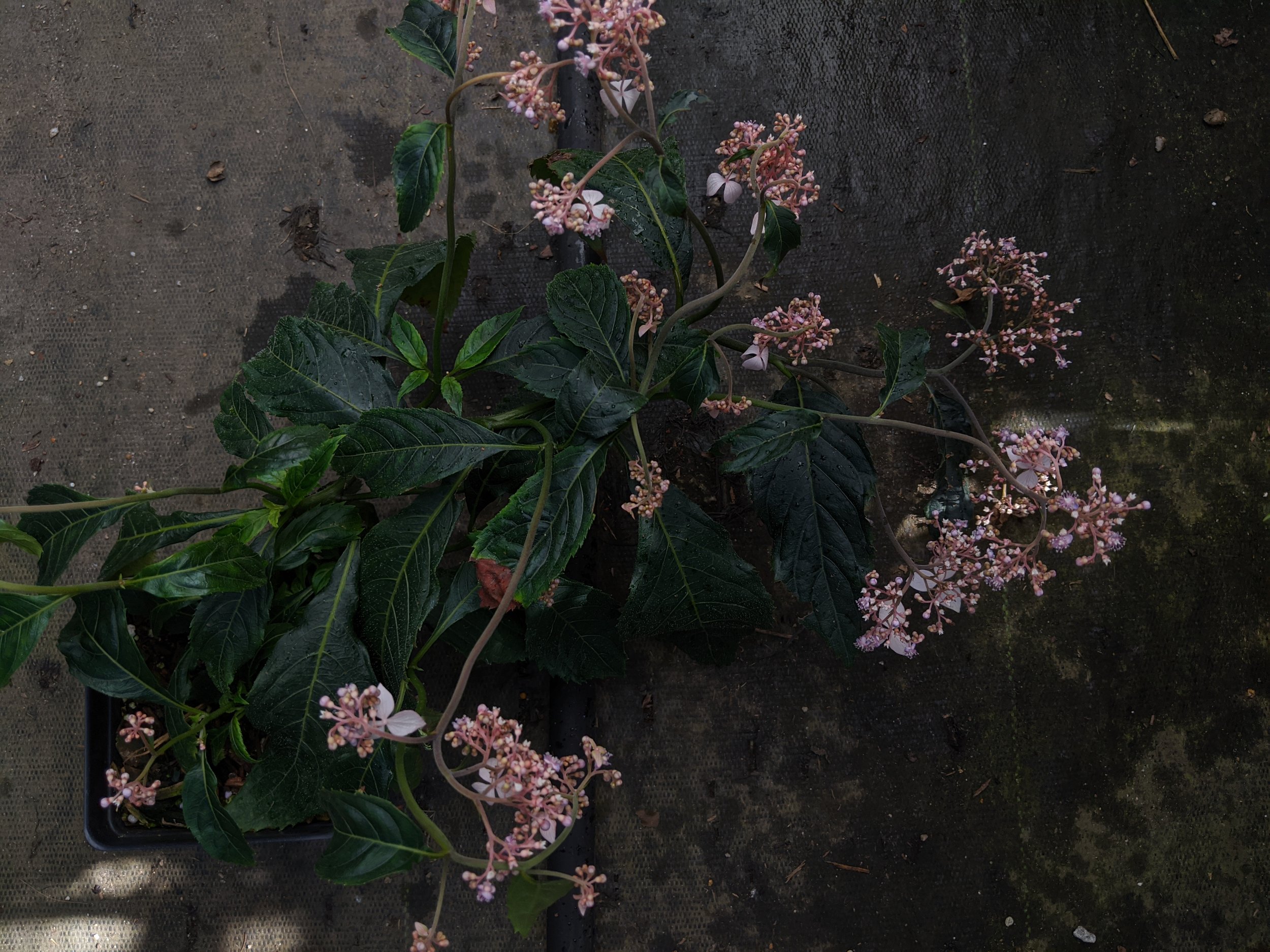
Cardiandra x agricola 'Star Power'
Selected here from a cross between C. alternifolia and C. fomosana due to its vigor, upright habit, flower production and sepal size. Best in light shade and moist, well drained soil. Z5?
Sanguisorba ‘Pacific Peweter’
Trans-Pacific fusion of Japanese S. hakusanensis and N. American S. menziesii. Conspicuous blue spring foliage mellows to pewter, with plum tassles from 3-4’ stems in Summer. Sun, adequate H20. Z5 at least.
Saliva ‘Rolling Thunder’
A three-way hybrid of S. omeiana ‘Crug Thundercloud’, S. flava var. megalantha, and S. nubicola, with large leaves, ruffled along the margin and purple beneath, and yellow flowers on 3’ stems in Summer. Needs shade and moisture in Summer. 3’, Z5,
Hydrangea 'Mountain Mania'
In house selection of H. serrata, the Japanese mountain species (and hence the mountain prefix) Tthis compact plant has orange new foliage, fading to yellow. Lacecap, with blue fertile flowers and white sterile florets. Best in part sun/part shade, as some sun necessary for best color. Moist, well drained soil. Z3—4’ x 3-4’ , Z5/6.
Salvia glabrescens 'Autumn Enchanter'
Our selection of this Japanese woodland species, born from an effort to get the larger pink flowers of glabrescens var. robustum on sturdier stems. Check. Two-toned, orchid pink flowers atop 30-32” stems in mid-autumn. Easy in shade to part shade, with well drained soil—forms tuberous roots, so winter drainage is paramount. Z5
Salvia glabrescens ‘Autum Equinox’
This is our cross, with flowers much larger than ‘Shi Ho’ and with similar two toned purple flowers and sturdy stemmed constitution. Valuable late flowering in shade - October here. Shade. Forms tuberous roots so winter drainage is paramount. Z5,
Geranium pratense 'Ghost Reiter'
Seed strain developed here from G. p. Victor Reiter, Jr. Near white flowers deepen pink with age over non-fading, deepest purple foliage. Compact and slow - a pale flowered counterpart to ‘Midnight Reiter’ To 8”x8”.
Bergenia 'Size Queen'
Not just, big, and not just hairy, this one’s big and hairy! This is a cross of the Dixter Form of Bergenia ciliata and ‘Green Monstah’, and while not as velvety as the former, it’s every bit as large in leaf as the latter (12-15” leaves) . Deciduous, as per both parents. Best with some shade, and summer water. Hardy to Z5
Eucomis ‘Rhode Island Red’
Not just big, not just purple, big and purple! This cross of ‘Sparkling Burgandy’ and pole-evansii has hybrid vigor and quickly develops dusky 2’ leaves, each with a slightly ruffled edge. Flowers are HUGE: pink on a dark, central stem. Sun for best color. Z6.
Sanguisorba ‘Drama Queen’
Selected here from var. parviflora with clear tenuifolia influence in its taller stature and longer inflorescences, but an incredibly sturdy upright habit. Many pendulous white bottlebrush flowers top sturdy 4-6’ stems in summer. Easy and floriferous in moist soil and sun-pt sun. Z4.
Kniphofia ‘Wet Dream’
The influence of K. thomsonii lends a high gloss to this late summer exclamation point. Rarely available as demand from cultish admirers outstrips quickly our supply. Very narrow, grassy foliage and freely flowering with lustrous flowers atop 3’ stems. Tough in dry spots and hardy to at least Z6.

